2023 Wisconsin Health Care Quality Report







Since early 2020 Wisconsin hospitals have managed care through times never seen before in our lifetimes, as we lived through the COVID-19 Public Health Emergency. With that brought a new plan of care model that had its challenges, but also additional flexibilities to help combat the virus. One thing is clear—Wisconsin hospitals were leaders in providing care not only within the hospital walls, but in the parking lots, clinics, public facilities, and the list goes on. Today, as we take insight and lessons learned from the pandemic, we see the emergence of the necessity of providing care across the continuum and the collaborations that will rise as a result.
Collaborating through these diverse community partnerships at the local and federal levels is the key to improving health and health equity in our society. To further strengthen the continuum of care across Wisconsin, the time is now for all settings of care (hospitals, rehabilitation centers, long-term care, specialized outpatient services, etc.) to come together with public health and insurers to optimize a health care approach that includes a focus on the triple aim—improving the patient experience of care, improving the health of populations, and reducing costs. It also includes going beyond the quadruple aim (addressing clinician burnout), to a quintuple aim, to include advancing health equity. These partnerships will enable conversations around the approaches necessary to fully understand the issues we face and the approaches now and moving forward—all in the spirit of transforming community and population health.
There is no doubt that Wisconsin continues to provide high-quality care focused on health care for all, as you will see in this year’s report, but barriers remain, such as when we see double-digit hospital staffing vacancy rates as noted in WHA’s 2023 Health Care Workforce Report. Or that patients have longer average length of stays due to a lack of post-acute care placement or other delayed discharge challenges. As we continue to work through solutions to these delays in care, to make improvements, accurate and timely data must be available. We can’t improve what we don’t measure. Wisconsin has always been a leader when it comes to quality and price transparency. Both CheckPoint (for 19 years) and PricePoint (for 20 years) display this type of data for our hospitals and consumers. It is through transparency of data from WHA’s Information Center that our patients can make informed decisions on the care plan that best suits their health and well-being.
Maintaining the well-being of Wisconsin’s health care team is also critically important, as research shows the safety and mindset of our caregivers directly influences patients' experiences and outcomes. Continuing forward, there will be a heightened focus on reducing health disparities by examining the impacts of social drivers of health and accurately collecting race, ethnicity and language patient information.
It is with immense gratitude that WHA is able to include with this report real hospital stories exemplifying the care they provide for each of us and our loved ones.
Eric Borgerding WHA President and CEO








As the COVID-19 pandemic came to a close, we reflect on the many changes in health care delivery. We find that the high-reliability cultures established in Wisconsin hospitals has allowed them to navigate this public health emergency with dedication, compassion, resilience and, most notable, a focus on patient-centered care. The infusion of high-reliability principles has created a network of hospitals and health systems that remain focused on improving quality and patient safety outcomes for their community members, as evidenced in numerous ranking and rating systems.
For the past 19 years, Wisconsin's acute care and critical access hospitals have remained committed to transparency voluntarily reporting more than 40 measures of quality and patient safety data via the Wisconsin Hospital Association’s (WHA) CheckPoint website (applicable to the patient populations they serve). CheckPoint allows Wisconsin hospitals to compare and benchmark progress against other hospitals in the state. Hospitals are often found contacting higher performing peers to identify best practices that can be implemented in their own organization. This sharing of best practices facilitates collaboration and rapid improvements.
When looking across the national landscape, Wisconsin is frequently recognized as a top-ten state, and often ranked in the top five for patient safety outcomes, as recognized by reputable agencies such as the Centers for Medicare & Medicaid Services (CMS) Star Ratings, the Agency for Healthcare Research and Quality (AHRQ) Quality and Disparities Report, U.S. News & World Report’s top hospitals, among others. Although not all hospitals are rated in the CMS Star Ratings report, 38% of Wisconsin hospitals received the highest 5-star rating (compared to 16% nationally) and 39% received a 4-star rating (compared to 26% nationally).
To thrive in this challenging environment, undertaking quality improvement projects is more important than ever. While Wisconsin’s health care landscape looks different these days, the fact remains that hospitals' focus on quality improvement is impressive and their stories are powerful. With data and analytics at their disposal, hospitals can prioritize projects to quantifiably improve care. Several Wisconsin hospitals have shared overviews of the initiatives they have worked on, both clinical and operational, and led by both clinical leaders and front-line caregivers. The impact is phenomenal, and we are proud to showcase their work in this report.
Wisconsin hospitals have persevered and have provided high-quality patient care.
In 2004, the Wisconsin Hospital Association (WHA) launched its voluntary hospital quality reporting program, CheckPoint CheckPoint was the first statewide, voluntary hospital quality reporting initiative in the country. It is designed to meet the demand for information on the quality of care provided by community hospitals.
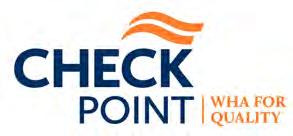
Improving health and patient care is essential to Wisconsin’s hospitals, health systems and clinicians. Each day, health care professionals and hospital executives work tirelessly to provide clinical expertise and leadership to reduce or prevent costly chronic diseases, maximize patient outcomes and improve health across the continuum of care.
Performance data on 45 metrics tracked by acute care and critical access hospitals across Wisconsin summarize the progress and trends on specific quality measures related to births, hospital-acquired infections, mortality, patient experience, patient safety and readmissions. By sharing information, Wisconsin hospitals can benchmark their progress against other hospitals in the state. In addition, the CheckPoint initiative has been a catalyst for Wisconsin hospitals to contact peers that are doing well in a clinical area to identify best practices that can be implemented in their own organizations. This sharing of best practices facilitates rapid improvement.
The mission of CheckPoint is to serve as a consumer-focused website that provides reliable, valid measures of health care in Wisconsin hospitals; to facilitate the selection of quality health care; and to assist quality improvement activities within Wisconsin’s hospital community. In order to ensure that health care measures remain evidence-based, aligned to state and national priorities, timely, and comparable, the CheckPoint tool is led by a Quality Measures team. The team represents more than 94 hospitals and 10 health systems in Wisconsin with the goal to bring forward a broad perspective for tracking measures that are suitable to all hospital sizes, and applicable to the geography and representative of the populations they serve. Team members are:
• Linda Drummond, UW Health
• Holly Francis, Mercy Hospital and Trauma Center
• Jason Gillis, HSHS WI Division
• Mbonu Ikezuagu, ThedaCare
• Christine Klement, Aspirus Langlade
• Dennise Lavrenz, WONL representative
• Amy Margeson, Advocate Aurora Health
• Kris Melass Merkel, Marshfield Medical Center
• Kayla Mobley, Tomah Health
• Sue Raduenz, Bellin Hospital
• Tom Rampulla, Ascension Wisconsin
• Lisa Sheldon, Gundersen Health System
• Colleen Sparr, SSM Health WI Regional Office
• Janet Wagner, Rural Wisconsin Health Cooperative
Kris Melaas-Merkel, Administrator, Acute Care Quality at Marshfield Clinic Health System
I have worked as a hospital quality professional for over 15 years. Early on in my career, I learned how progressive WHA was with sharing hospital quality information via CheckPoint. For decades, WHA has led the way in the U.S. with making quality measure data available on the CheckPoint website. CheckPoint greatly benefits consumers who can access it for important quality information and hospital leaders who can access it for benchmarks.
Since 2019, I have had the honor to be the chair of the WHA Quality Measures Team. The Quality Measures Team is composed of dedicated and experienced health care quality professionals across the state of Wisconsin. Team members provide input to WHA leaders on the many quality measures and insights to help CheckPoint continue to be a value-added website. I am so grateful to the WHA team for their expertise, their vision and their continued commitment to data transparency. In addition, I feel fortunate to chair the team that partners with WHA leaders to support CheckPoint in being an invaluable resource to both consumers and health care professionals.
Kris Melaas-MerkelFollowing are a few Wisconsin highlights as featured in CheckPoint for this past year.
The Wisconsin State Lab of Hygiene has a program for receiving specimens from all birthing hospitals around the state. The Newborn Screening Program screens infants born in Wisconsin for 48 disorders, hearing loss and critical congenital heart disease with the goal to receive all specimens within 72 hours. Specimen delivery times remain relatively unchanged during the pandemic with target transit time remaining over 99% on average.
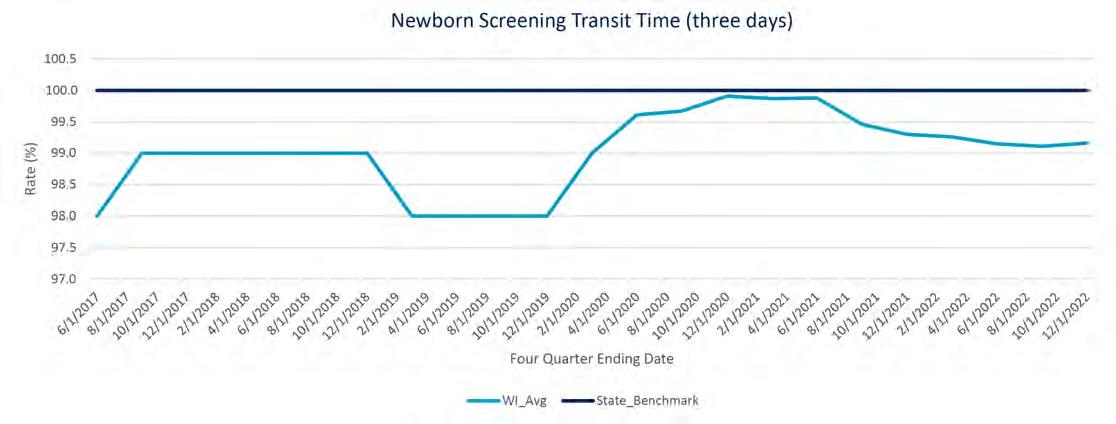
The charts below depict a representation of continuing to focus and drive down the occurrences of hospital-acquired infections. The data for both C. Diff (Clostridioides difficile) Infection and Methicillin-resistant Staphylococcus aureus (MRSA) rates during the pandemic remained well below what the “expected” or “predicted” rate of infections were calculated to be. To explain further, a Standardized Infection Ratio (SIR) well below 1.0 demonstrates that fewer infections were observed in that hospital during that time period than originally predicted. SIR is the primary summary measure used by the Centers for Disease Control and Prevention (CDC) National Healthcare Safety Network to track healthcare-associated infections over time. SIR is calculated by dividing the actual number of infections by the predicted number of infections. SIR of less than 1 means the number of actual infections is less than the number of predicted infections. SIR greater than 1 means the number of actual infections is greater than the number of predicted infections. Therefore, an SIR number of less than 1 is better.
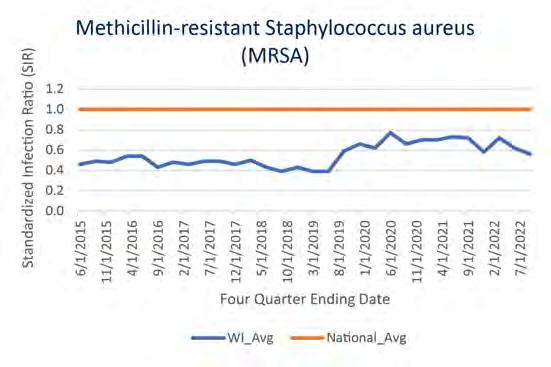

SIR <1 is better
SIR <1 is better
Wisconsin's Surgical Site Infections (SSI) for Abdominal Hysterectomy and Colon Surgery Standardized Infection Ratio rates remain lower than the national average. As noted by the CDC, the COVID-19 impact on hospital-acquired infections is due to continued changes to hospital practices, longer patient length of stay, additional co-morbidities and higher patient acuity levels, and longer, more frequent use of devices likely contributed to an overall increased potential for device-associated infections during the pandemic.

The latest performance data available on hospital-acquired infections is as follows:
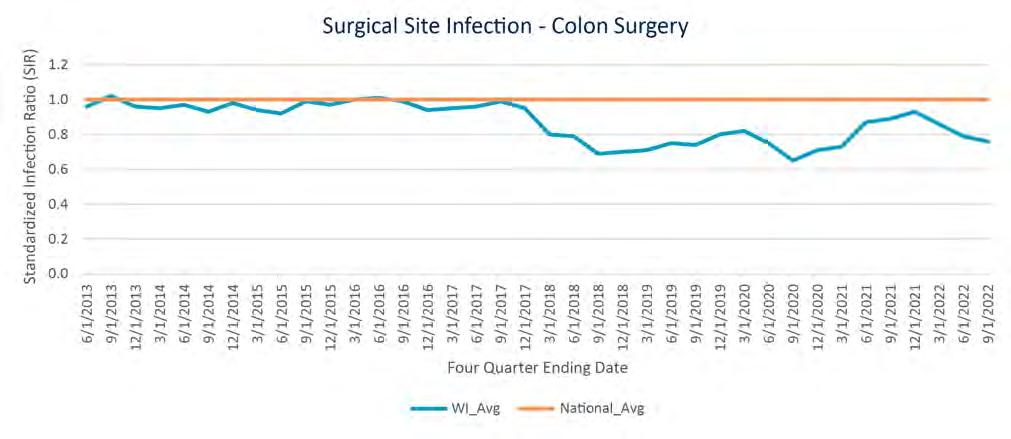
Patient Experience:
Wisconsin hospitals in aggregate performed better than the national average with the top 10% showing results up to 15% higher ratings than hospitals nationally. In fact, all ten measures of nationally reported patient satisfaction data shows Wisconsin hospitals performing better than the national average.
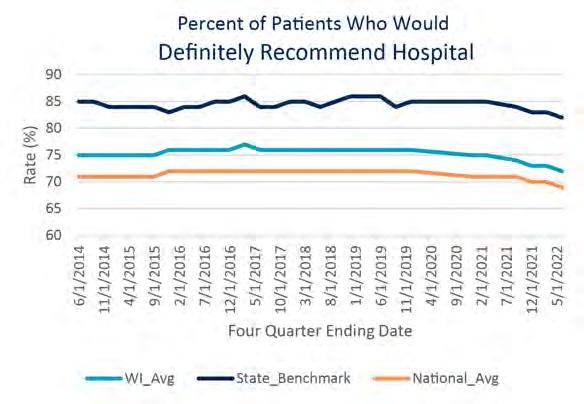

Readmissions:
CheckPoint’s All-Cause Readmissions measure is a WHA-derived measure to show more recent data than is published by other sources, and therefore does not have a national average associated with it. Wisconsin surpasses the national average in readmissions data reported for common diagnoses such as Chronic Obstructive Pulmonary Disease (COPD), Heart Failure, Heart Attack, Hip and Knee Surgery, and Coronary Artery Bypass Graft.

Data leading up to the pandemic for readmissions broken down by chronic disease shows Wisconsin performing better (lower) than the national average. The Centers for Medicare & Medicaid Services (CMS) suppressed the Pneumonia Readmissions results and therefore there are no results for this time period (denoted as CRS: COVID Result Suspension). This is the latest data available and will not show for 2022 at this time.
Consumers have many ways that they can review and compare quality and patient safety outcomes as evidenced by the multitude of ranking and rating dashboards and scorecards publicly available. This not only demonstrates the transparency of the data but gives a variety of perspectives of what good quality should look like. Each program identifies measures to report on from numerous secondary data sources and publicly reports this data.
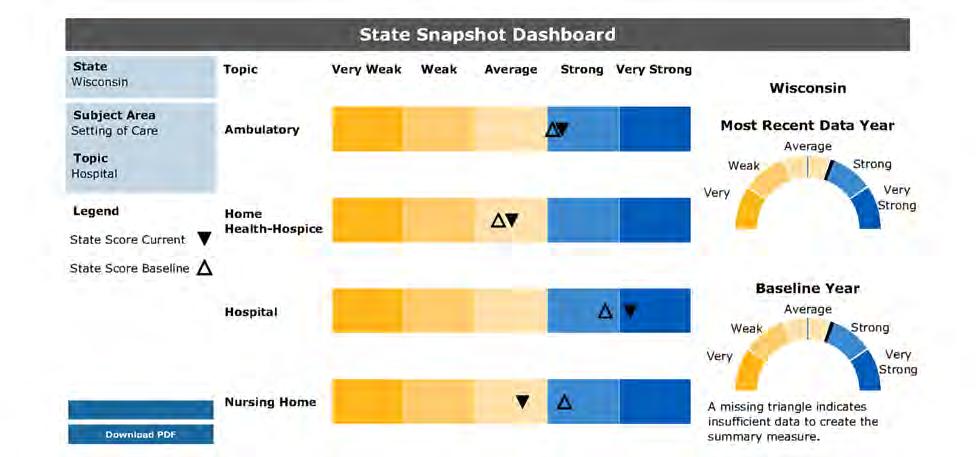
For the 20th year, the Agency for Healthcare Research and Quality (AHRQ) publishes their National Healthcare Quality and Disparities Report that assesses the performance over six priorities: patient safety, person-centered care, care coordination, effective treatment, healthy living and care affordability. AHRQ then presents an overview by state called the “State Snapshots” that allow consumers and private partners to better understand health care quality and disparities in each state. Data comes from a variety of sources and represents multiple care settings. This comparison presents the care by setting in which it shows improvement over the baseline. State Snapshots were most recently issued by AHRQ in October 2022 and shows Wisconsin hospital quality measures improvement over the baseline metrics.
Source: https://datatools.ahrq.gov/nhqdr
Also published in the AHRQ October 2022 National Healthcare Quality and Disparities Report, Wisconsin is ranked in the top quartile for best quality across all states. Scores are based on the number of measures above, at, or below the average across all states and can be seen here:
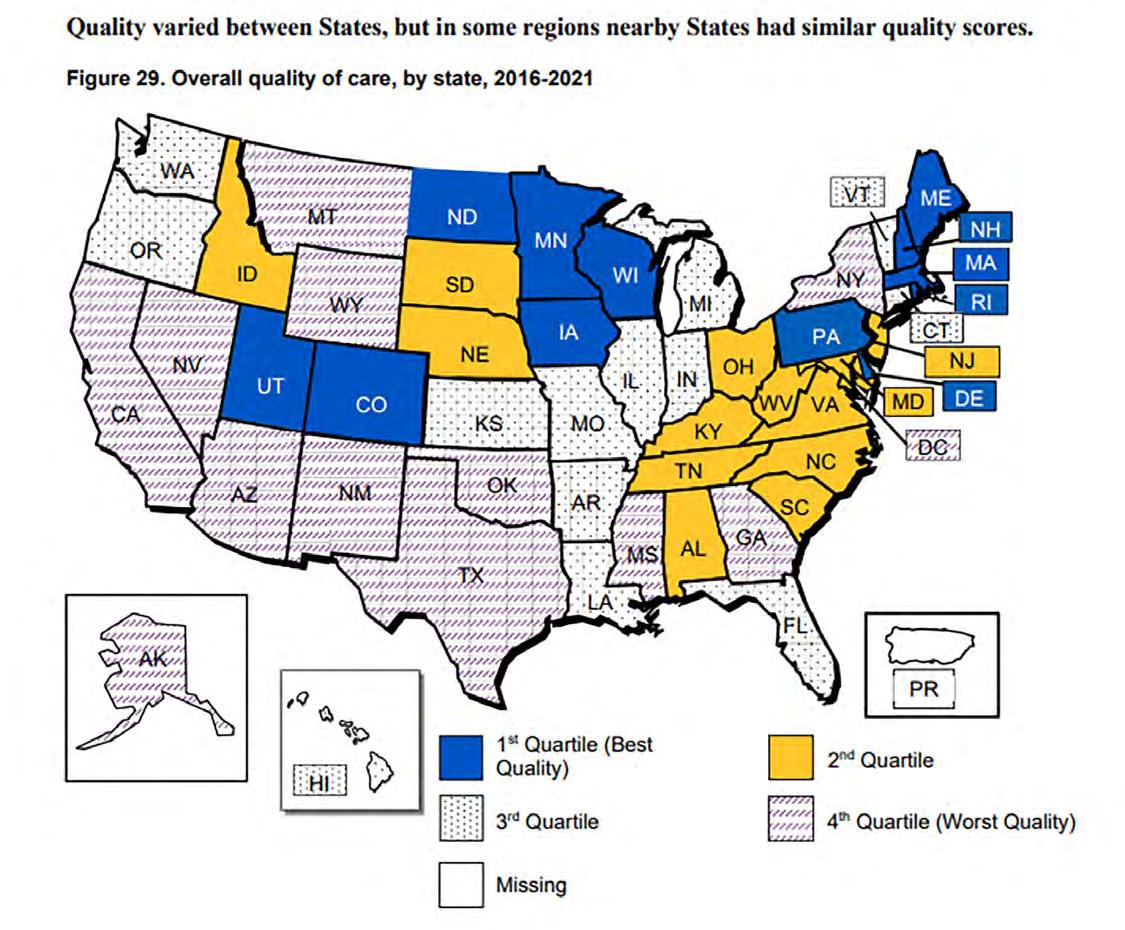
Source: https://www.ahrq.gov/sites/default/files/wysiwyg/research/findings/nhqrdr/2022qdr.pdf
A separate source that provides quality ratings and rankings, The Commonwealth Fund, posted their Scorecard on State Health System Performance in June 2022. Each year The Commonwealth Fund posts their scorecard based on the latest available data to assess how well health care organizations provide high-quality, accessible, and equitable health care. This year’s report also included measures on how well each state responded to and managed the COVID-19 pandemic.
Wisconsin ranks 21st overall nationally and second overall in the Great Lakes region with the latest data available (most of 2020, 2021 and early 2022) aggregated from 56 performance indicators.
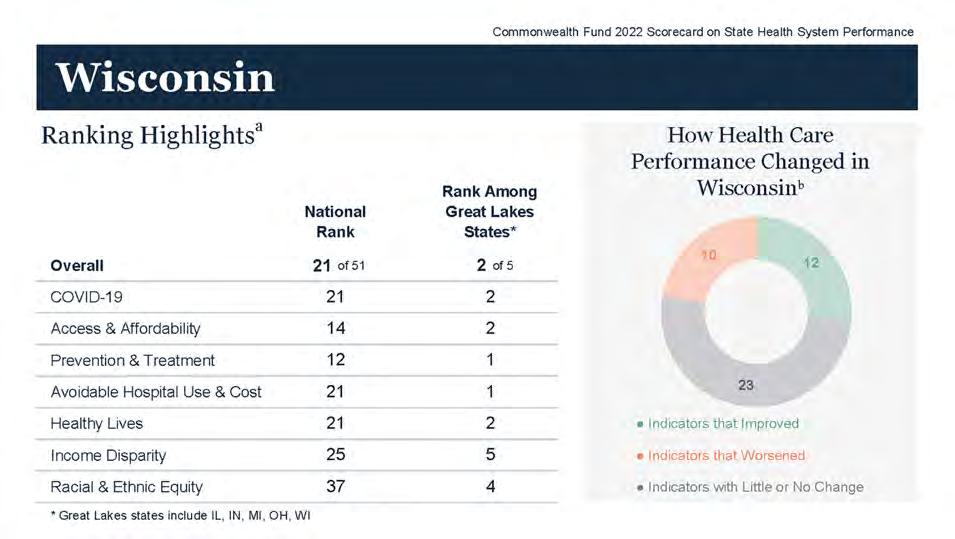
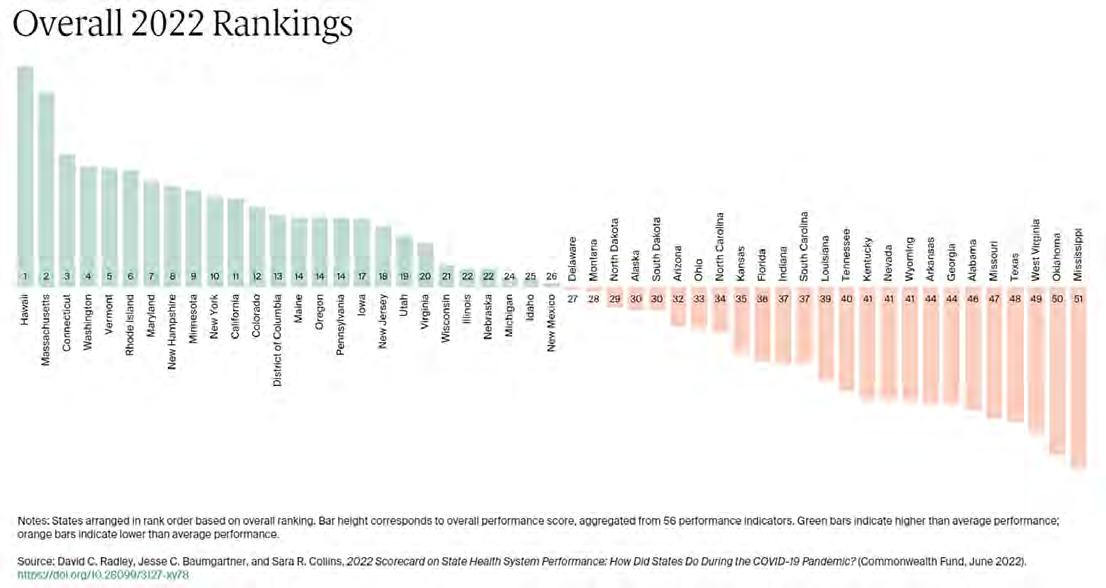
Source: https://interactives.commonwealthfund.org/2022/state-scorecard/Wisconsin.pdf
Data transparency allows the opportunity to look for areas of improvement and is an important aspect of improving patient outcomes and advancing care.
According to the Centers for Medicare & Medicaid Services (CMS), the Hospital Value-Based Purchasing (VBP) Program is part of the long-standing effort by CMS to link Medicare's payment system to health care quality in the inpatient setting. Some hospitals are excluded from the Value-Based Purchasing Program, such as critical access, psychiatric, rehabilitation, children’s, cancer clinics and others.

The Hospital VBP Program is designed to promote better clinical outcomes for hospital patients, as well as improve their experience of care during hospital stays, while reducing costs to make care affordable. Specifically, Hospital VBP seeks to incentivize hospitals to improve the quality and safety of care that patients receive during acute-care inpatient stays.
In the FY 2023 Inpatient Prospective Payment System (IPPS)/Long Term Care Hospital Prospective Payment System final rule issued on Aug. 10, 2022, CMS determined that circumstances caused by the COVID-19 public health emergency significantly affected National Healthcare Safety Network healthcare-associated infection, Hospital Consumer Assessment of Healthcare Providers and Systems (HCAHPS) survey, and the Pneumonia 30-Day Mortality measure in the FY 2023 Hospital VBP Program. As a result, in the final rule, CMS paused those measures from the FY 2023 Hospital VBP Program. Because CMS is pausing measures, CMS believes there will not be enough data to award a Total Performance Score to any hospital in FY 2023. As a result, no hospital will have a Total Performance Score calculated and no hospital will have payments adjusted due to the Hospital VBP Program in FY 2023.
The goals of CMS’s Hospital Value-Based Purchasing Program include:
• Eliminating or reducing the occurrence of adverse events (e.g., health care errors resulting in patient harm);
• Adopting evidence-based care standards and protocols that result in better outcomes for Medicare patients;
• Re-engineering hospital processes that improve patient experience of care;
• Increasing the transparency of care quality for consumers, clinicians and others; and
• Recognizing hospitals that are involved in the provision of high-quality care at lower cost to Medicare.
Bonuses are paid from a 2% withhold from all participants to top performing hospitals that score higher than average when comparing a hospital’s “achievement” and “improvement” for each measure in the program. Scores are calculated based on measures within four domains, each weighted equally at 25%:
• Efficiency and cost reduction: Medicare spending per beneficiary
• Safety: hospital-acquired infections
• Clinical outcomes: mortality and complications
• Person and community engagement: patient satisfaction/Hospital Consumer Assessment of Health Care Providers and Systems (HCAHPS) scores
A summary of the Hospital Value-Based Purchasing Program for fiscal year 2023 is available here.
The Hospital-Acquired Condition (HAC) Reduction Program is a Medicare value-based purchasing program that reduces payments to hospitals based on how they perform on measures of hospital-acquired conditions.
The HAC Reduction Program encourages hospitals to implement best practices to reduce their rates of healthcare–associated infections (HAIs) and improve patient safety. Section 1886(p) of the Social Security Act sets forth the statutory requirements for the HAC Reduction Program, which requires the Secretary of the U.S. Department of Health and Human Services to adjust payments to hospitals that rank in the worst-performing quartile (above the 75th percentile) of all subsection (d) hospitals with respect to measures of hospital-acquired conditions. On an annual basis, the Centers for Medicare & Medicaid Services (CMS) evaluates overall hospital performance by calculating a Total HAC Score for each hospital as the equally weighted average of their scores on measures included in the program. Hospitals with a Total HAC Score greater than the 75th percentile of all Total HAC Scores will receive a payment reduction of 1% on overall Medicare fee-for-service payments.
CMS is not calculating measure scores or the Total HAC Score for any hospital in FY 2023 as finalized in the FY 2023 Inpatient Prospective Payment System/Long-Term Care Hospital Prospective Payment System (IPPS/LTCH PPS) final rule. No hospital is receiving a payment reduction for the HAC Reduction Program for FY 2023. CMS is still publicly reporting hospitals’ HAI and CMS PSI 90 results on the Care Compare website to provide transparency to the public on important infection and patient safety metrics during the COVID-19 public health emergency.

CMS includes the following measures in its HAC Reduction assessment:
Claims-based composite measure of patient safety:
• MS PSI 90 (patient safety and adverse events composite)
CDC NHSN (Centers for Disease Control and Prevention National Healthcare Safety Network) health care-associated infection measures:
• CLABSI (central line-associated bloodstream infection)
• CAUTI (catheter-associated urinary tract infection)
• SSI (surgical site infection for abdominal hysterectomy and colon procedures)
• MRSA (methicillin-resistant Staphylococcus aureus)
• CDI (Clostridioides difficile infection)
A fact sheet related to the Hospital-Acquired Condition Reduction Program is available at https://qualitynet.cms.gov/inpatient/hac.
The Hospital Readmissions Reduction Program (HRRP) is a Medicare value-based purchasing program that reduces payments to hospitals with excess readmissions. Under HRRP, hospitals are encouraged to improve communication and care coordination to better engage patients and caregivers in discharge plans and, in turn, reduce avoidable readmissions.
CMS includes the following measures in its Hospital Readmissions Reduction Program (HRRP) assessment:
• Acute myocardial infarction
• Heart failure
• Pneumonia
• Chronic obstructive pulmonary disease
• Total hip and/or total knee arthroplasty
• Coronary artery bypass graft surgery
CMS calculates a payment reduction for all HRRP-eligible hospitals. CMS applies the payment reduction to all Medicare fee-for-service base operating diagnosis-related group payments regardless of condition or procedure.

A fact sheet related to the HRRP is available at https://qualitynet.cms.gov/inpatient/hrrp.
As finalized in the FY 2022 IPPS/LTCH PPS final rule, the Centers for Medicare & Medicaid Services (CMS) is suppressing the pneumonia readmission measure in FY 2023 HRRP payment reduction calculations due to COVID-19’s substantial impact on this measure. CMS is still calculating and publicly reporting measure results for the pneumonia readmission measure. However, the pneumonia readmission measure results do not contribute to FY 2023 payment reduction calculations. Payments within this program may be reduced by up to 3% depending on the performance outcomes for each of the six identified measures. Eighteen Wisconsin hospitals (27% of eligible hospitals) will receive no penalty this year. Nationally, this remains an area of focus, and Wisconsin performs higher than the national average (25% will have no penalty nationally). More Wisconsin hospitals had no penalty or a slight penalty than in the previous three years.
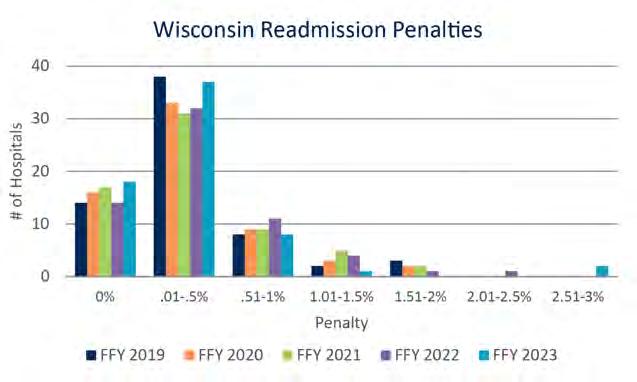
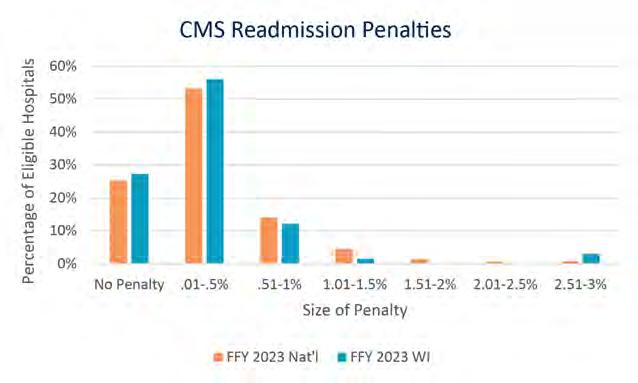
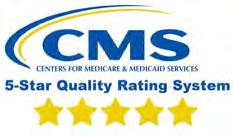
Hospitals have long been pioneers in quality measurement and have long shared safety and quality data with the public. The large volume of information on the Care Compare website and Provider Data Catalog and the specialized focus of many of the measures publicly reported could overwhelm patients and consumers. The intent of the Overall Star Rating (refreshed in July 2023) is to summarize a wide range of publicly reported measures in a single metric.
The Overall Star Rating reflects 46 measures across five aspects of quality:
1. Mortality
2. Safety of Care
3. Readmissions
4. Patient Experience
5. Timely & Effective Care
The Overall Star Rating supplements, rather than replaces, the information on Care Compare.
The following national and local statistics representing the stratification of Star Ratings across all U.S. hospitals are below.
N = 3061
The following table shows how Wisconsin hospitals performed compared to the national data above.
N = 77
In Wisconsin, 38% of rated or qualifying hospitals (thresholds must be met) have a 5-star rating compared to 16% nationally achieving that 5-star status; an increase of 6% from the July 2022 star ratings refresh.
The number of four- and five-star hospitals in Wisconsin represent 77% of rated hospitals, largely exceeding the national average.
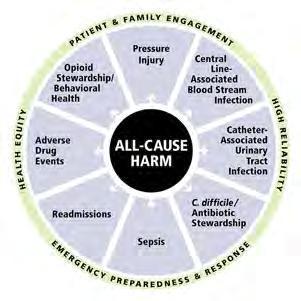

The Superior Health Quality Alliance (Superior Health) is comprised of eight member organizations—all with long track records of success driving achievement of Medicare quality improvement goals as a Quality Innovation Network – Quality Improvement Organization (QIN-QIO), Hospital Improvement Innovation Network (HIIN), and/or EndStage Renal Disease Network (ESRD). Member organizations include:
1. Illinois Health and Hospital Association
2. MetaStar
3. Michigan Health & Hospital Association
4. Midwest Kidney Network
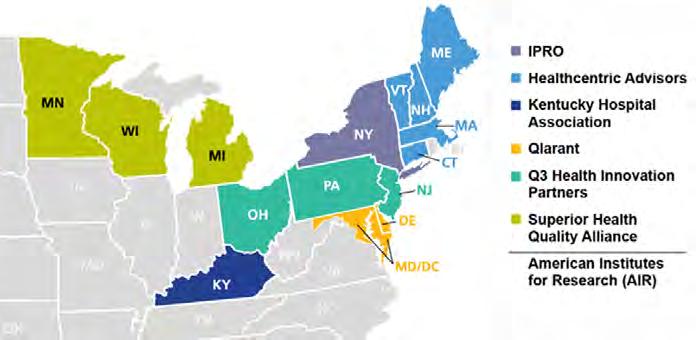
5. Minnesota Hospital Association
6. MPRO
7. Stratis Health
8. Wisconsin Hospital Association
This combined “Power of Eight” works with hospitals, providers, community partners, beneficiaries and nursing homes on quality improvement initiatives to improve quality of care and patient outcomes across our combined states.
The Wisconsin Hospital Association and Superior Health have been serving as the Hospital Quality Improvement Contract (HQIC) for Michigan, Minnesota and Wisconsin under a subcontract with IPRO since early 2021. The IPRO HQIC supports participating hospitals by strengthening existing patient safety processes and facilitating quality improvement strategies to improve patient safety and reduce allcause harm. The network includes approximately 270 rural, critical access, and acute care hospitals serving vulnerable populations across 12 states. Superior Health serves 124 of the 270 hospitals, and WHA serves 32 rural and/or critical access hospitals of the 124 Superior Health hospitals.
“The HQIC has been instrumental in helping us improve quality by providing resources, training and support for our Antibiotic Stewardship, Opioid Stewardship, and our Sepsis Committees. HQIC is definitely my first 'go to' resource!”
- Shelly Egstad, Director of Quality/Risk/Compliance, Tomah Health
WHA offers ongoing technical assistance focused on person and family engagement, health equity practices, engaging hospital leadership and addressing patient safety priority areas. Technical assistance is offered in the form of webinars, learning action networks, affinity groups, improvement sprints, 1:1 coaching calls and hospital quality leader check-in calls. Participant networking, access to evidence-based resources, and communication of events and opportunities is also encouraged via a monthly newsletter and HQIC Superior Health Connect, an online community forum.
In 2022, 97% of Wisconsin hospitals participated in two or more offerings and greater than 50% participated in five or more offerings.

““The benefit of having the HQIC team is the supportive resources that are gained with the improvement opportunities for the quality measures. The roadmap sprints are helpful as they provide opportunities to evaluate your current state and complete a gap analysis for areas to improve patient outcomes. These resources are provided to you versus having to go out independently and complete the research. This efficiency is advantageous as health care is very challenged with resources to do this work.”
- Heather Schmidt, Director of Quality and Patient Safety, Marshfield Medical Center
This scope of work is in the third year of a five-year contract with the Centers for Medicare & Medicaid Services (CMS). WHA’s quality improvement team participates on the health disparities (Person and Family Engagement and Health Equity Group) and the immunization teams (Infection Prevention and Control Group) with a focus on contacting CMS-identified nursing homes to gather COVID-19 up-to-date booster vaccination data, helping to organize vaccine clinics, providing educational resources and participating in weekly roundtable discussions. Disparities are being identified by zip code in three major cities in Michigan, Minnesota and Wisconsin. In Wisconsin, Milwaukee County has been identified as an area of need for improving health disparities and will receive focused education and networking opportunities.
Many Wisconsin hospitals actively participate with entities in the Partnerships for Community Health (PCH) initiative. These hospitals and health systems work alongside various Wisconsin entities to improve the health of the communities they serve. Coalitions from all regions of the state are represented and are working on Falls Prevention, Population Health Management, Advance Care Planning, Adverse Childhood Experiences, Housing, Mental Health, Transitions In Care, Medication Management, and Workforce.
Participating hospitals and health systems include:
• Advocate Health
• Ascension NE Wisconsin – Mercy Campus
• Ascension NE Wisconsin – St. Elizabeth Campus
• Aurora BayCare Medical Center
• Aurora Medical Center -Kenosha
• Bellin Health System
• Door County Medical Center
• Froedtert Pleasant Prairie Hospital
• Gundersen Lutheran Medical Center
• HSHS St. Mary’s Hospital Medical Center
• HSHS St. Vincent Hospital
• Mayo Clinic Health System – La Crosse
• SSM Health Monroe Hospital
• ThedaCare
A total of 1,028 nursing homes in 46 communities were engaged in the collaborative during 2022. A significant focus on education has been developed in the first three years of the contract with one example covering 11 education modules designed for patient care staff: “Front Line Forces: A Direct Care Staff Education and Collaboration Series,” focusing on caregiver wellbeing, falls prevention, substance use disorder, behavioral interventions, vaccination and others. The second educational program design, “Shine a Light on Stigma,” shared messages of wellness, hope and recovery while reducing the stigma around substance use disorder.
A partnership with Real Time Medical Systems (RTMS) allows skilled nursing facilities the ability to share their real-time data for early identification in a change of resident status. RTMS offers a post-acute analytic software application that generates a live sync with key data points within a nursing home’s electronic health record that allows subtle changes to be identified in a resident’s condition and highlights high-risk residents in need of clinical prioritization. This allows for earlier interventions to be initiated, reduces rehospitalizations and supports improved quality of care. Access to clinical alerts, dashboards, and aggregate and resident-specific detail help to support these outcomes as well as many of the CMS evaluation measures. Leveraging this data will be further implemented in 2023 with a goal to include 300 facilities.

The RHeSUS program was developed by the Wisconsin Hospital Association (WHA) in partnership with Randy Brown, MD, UWMadison School of Medicine and Public Health, and aims to reduce substance abuse/misuse in rural Wisconsin through the dissemination of several evidence-based, in-person and virtual, consultative, and educational provider and patient services focused on rural communities. The goals of the program include increasing access to evidence-based medical care for rural residents struggling with addiction and reducing adverse outcomes to alcohol, opioids, and substance use disorders over five years. The offerings target health care providers and their teams who serve and treat rural Wisconsinites struggling with opioid and other substance misuse.

2022 Highlights
• Facilitated two Substance Use Disorders Management Bootcamps.
• Offered Data Waiver training.
• Launched monthly RHeSUS Lunch and Learn webinars in September 2022.
• Launched monthly expert-facilitated RHeSUS office hours in June 2022.
Program Outcomes
• Made at least 179 connections with providers and health care personnel who provide SUD/ OUD care to rural Wisconsin communities.
Next Steps
• Ongoing offerings: Substance Use Disorders Management Bootcamps, RHeSUS Lunch and Learn webinars, office hours
• Increase awareness: advisory board, website, social media, podcasts, access to peer recovery, and more
• Expand and strengthen strategic partnerships
Funding for RHeSUS was provided by the UW School of Medicine and Public Health from the Wisconsin Partnership Program’s (WPP) Community Impact Grant.
For more information on how you can engage in these offerings, contact Jill Lindwall.
As the number of older patients increases, health systems face the challenge of caring for patients with multiple health and support issues. To address this challenge, administrators and health care professionals across Wisconsin began regularly meeting in 2022 to spread the message that an evidence-based age-friendly approach is replicable, results in better patient outcomes, and can reduce the total cost of care with a favorable return on investment.
With support from U.S. Sen. Tammy Baldwin and a grant from the Health Resources and Services Administration, the Wisconsin Geriatric Education Center convened a statewide partnership group to learn more about a national initiative titled, “Age-Friendly Health Systems,” and to spread its quality improvement approach to more health care sites in the state. In its early stages, interested partners learned from the experiences of those organizations that are already implementing Age-Friendly practices.
Age-Friendly Health Systems is a national initiative launched in 2017 by The John A. Hartford Foundation and the Institute for Healthcare Improvement (IHI), in partnership with the American Hospital Association and the Catholic Health Association of the United States. The initiative first focused on building age-friendly care within hospital inpatient settings and has more recently expanded to include outpatient settings, primary care, emergency departments, home care and skilled nursing facilities.
In 2022, the IHI reported that more than 2,900 health care sites in the U.S. had earned recognition as either a “Level 1 Participant” (sites that successfully developed plans to implement age-friendly care), or as “Level 2 Committed to Care Excellence” (sites that collected at least three months of data). At the end of 2022, Wisconsin had 15 sites recognized by IHI as Committed to Care Excellence and another three sites listed as Participants.
The goal of the newly formed Wisconsin Age-Friendly Partnership is to expand these numbers throughout the state. This work will continue in 2023 with a webinar series to educate and empower Wisconsin’s workforce; a peer support network for clinicians who are working to implement Age-Friendly care; the dissemination of guides, workbooks, & other resources about age-friendly care; expansion of “Geriatric Fast Facts” (GeriatricFastFacts.com) and “Palliative Care Fast Facts” (MyPCNow.org/fast-facts) to highlight the 4Ms; and dissemination of age-friendly information throughout the state via conferences, newsletters, etc. The Wisconsin AgeFriendly Partnership is working with IHI to ensure that local health systems have access to the information, expertise, and ongoing support needed to implement the framework across a variety of health care settings.
The Age-Friendly Health System initiative uses a framework of four evidence-based elements of high-quality geriatric care, referred to as the “4Ms”—What Matters, Medication, Mentation and Mobility.
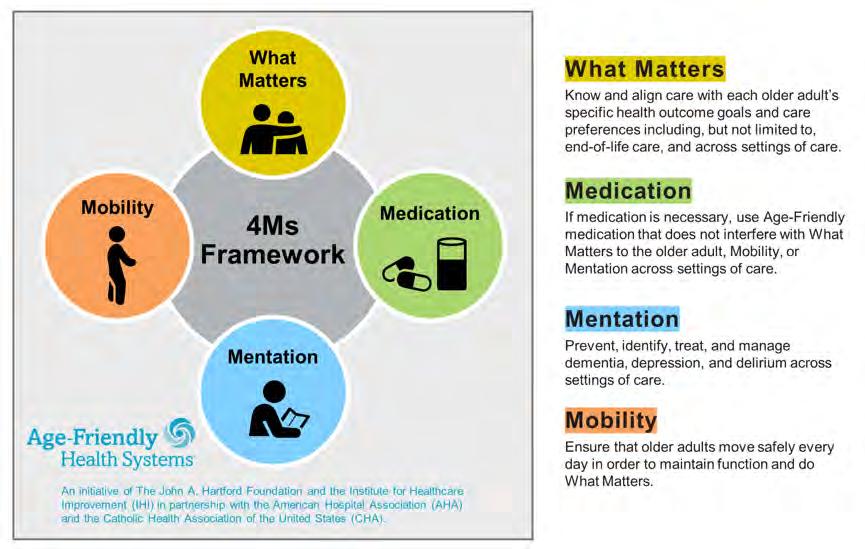
Outcomes from health systems that have implemented the 4Ms framework have included:
• Improved physiological and psychological health for older patients
• Better alignment with patients’ health goals and care preferences
• Reduced polypharmacy in older patients
• Improved detection and management of delirium, depression, dementia
• Reduced number of falls in older patients
• Reduced total cost of care
• Reduced length of hospital stays
It is worth noting that Advocate Health’s homecare program, “Health at Home,” also implemented the Age-Friendly 4Ms framework in their design of the “perfect patient visit” including standardized documentation. Orientation for new team members now includes the 4Ms and quality improvement plan-do-study-act cycles are performed through review of the patient electronic medical record.
Because of this pioneering work as a system leader, the Institute for Healthcare Improvement (IHI) has asked Advocate Health for its assistance in the development of new Age-Friendly homecare implementation guidelines to add to the IHI toolkit.
Wisconsin emergency departments (EDs) see more than 18,000 patients annually for non-traumatic dental pain each year. As a chief complaint, non-traumatic dental pain (NTDP) consistently ranks among the top three for most avoidable ED visits and represents a prime opportunity for member hospitals to decrease opioid prescriptions. From a patient satisfaction standpoint, these patients are frequently triaged as a low priority, wait for hours to be seen, are sometimes given unnecessary antibiotics, and rarely have their problem definitively addressed. Often a “band-aid” type solution, patients may walk out of the ED with a recommendation to have a tooth extraction or root canal and an outdated list of local dentists that accept Medicaid. Bounce back ED visits for pain control are common, as the underlying dental issues have not been addressed. Even if the initial ED visit ended with a non-opioid pain control strategy, it is hard for frontline providers to not reach for that prescription pad when the patient is suffering, and no dental follow-up is in sight.
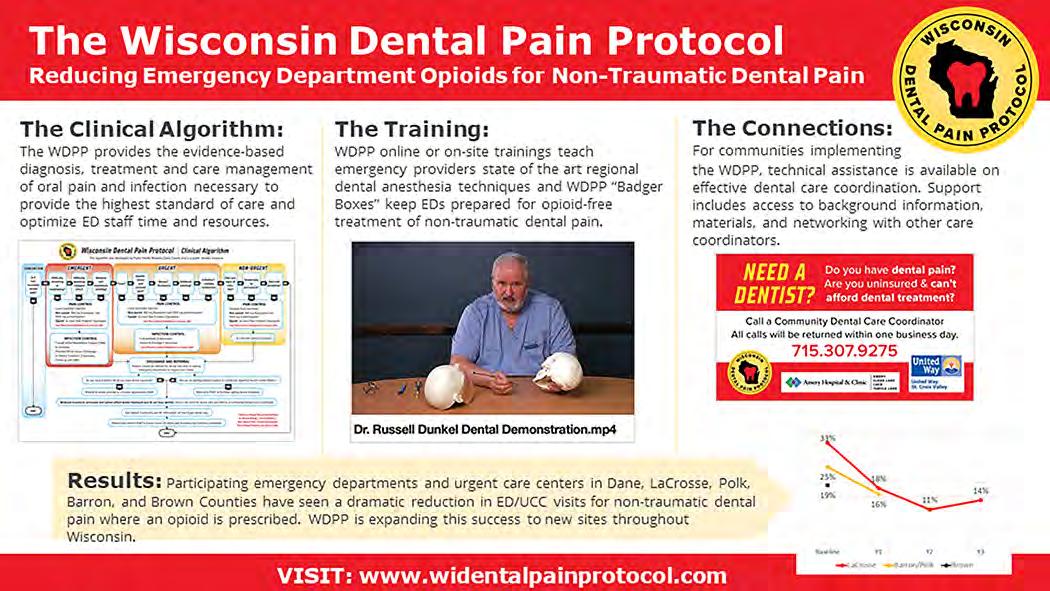
To help its member hospitals combat the opioid epidemic, increase patient satisfaction, and reduce ED crowding, WHA has teamed up with state and local dental coalitions, ED/dental professional organizations, and members of the community to advance the mission of the Wisconsin Dental Pain Protocol (WDPP). The WDPP provides the evidence-based diagnosis, treatment, and care management of oral pain and infection necessary to provide the highest standard of care and optimize ED staff time and resources. WDPP aims to reduce opioid prescribing by training local EDs and urgent care centers in dental anesthesia and connecting EDs and urgent care centers with local dentists to improve outcomes for patients with NTDP.
In its inaugural three years, the WDPP has delivered promising results, training 68 ED providers to perform high-yield dental blocks and referring over 800 patients for community dental care. Of those referred, approximately 75% received definitive care for their acute problem and many were able to establish preventive continuity dental care to break the cycle of ED use for NTDP. Moreover, opioid prescriptions for NTDP have decreased by over 40% at participating sites.
"The Wisconsin Dental Pain Protocol is fulfilling a necessary role in Wisconsin, bridging emergency departments and outpatient dentistry. The program gave our health system a roadmap to reduce ED bounce backs for non-traumatic dental pain and ultimately reduce the amount of opioids being prescribed in our community. For our emergency physicians, the actual dental block training was a great experience. WDPP brought in the same local dentists that we will be referring our patients to. This introduction initiated a great working relationship.”
- Dr. Kerry Ahrens, president of the Wisconsin Chapter of the American College of Emergency Physicians and director of the Aurora BayCare ED in Green Bay
To help facilitate ED onboarding and hospital logistics, WHA Physician Improvement Advisor Bobby Redwood, MD, was brought on to the project in 2022. Working together with statewide dental leaders and local care coordination agencies, WHA lends our quality improvement expertise to help ensure that new sites are successfully launched and set up for long-term success. After getting buy-in from hospital leadership and engaging key stakeholders in the ED and dental community, WDPP typically holds a kickoff meeting with each new hospital and surrounding community. WDPP then coordinates both online and on-site trainings to teach or refresh emergency providers on state-of-the-art regional dental anesthesia techniques and also provides WDPP “Badger Boxes” to keep EDs prepared for opioid-free treatment of non-traumatic dental pain. Next, the WDPP quality and technology teams ensure that data collection and care coordination are properly planned and executed, so there is minimal burden on ED staff. Finally, our dentist champions and dental coordination team work tirelessly to build and maintain a robust network of local dentists who are willing and able to see these patients in a timely fashion for definitive follow-up.
As of 2023, participating EDs and urgent care centers in Dane, La Crosse, Polk, Barron, Oconto, and Brown Counties have seen a dramatic reduction in ED/urgent care center visits for non-traumatic dental pain where an opioid is prescribed and WDPP continues to expand this success to new sites throughout Wisconsin.
To learn more about the WDPP or how it might be implemented in your ED, David Gundersen, DDS, MPH at info@ widentalpainprotocol.com, 608-443-8986, or peruse the Wisconsin Dental Pain Protocol website.
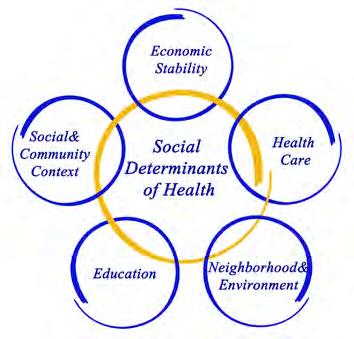
Achieving health equity involves taking an organizational strategic approach that includes stratifying data and taking deliberate and intentional action to close the gaps and reduce disparities. Eliminating health care disparities takes a strong commitment to the collection of accurate, complete and meaningful patient demographic data, a fundamental step in identifying and eliminating disparities in care. Collecting race, ethnicity, and language (REaL) data, as well as expanding the collection of disability status, sexual orientation/gender identity, veteran status, geography and other social determinants of health (SDOH) or social risk factors assists health organizations to better understand their patient populations and their needs.
The HEOA evaluates the ability to identify and address health disparities in several evidence-based areas, including data collection, data collection training, data validation, data stratification, communicating findings, organizational infrastructure & culture, and Z-code collection. Once the re-launch of the HEOA survey in 2022 was complete, a resources guideline was created for hospitals to assist in bringing forward strategies directly to hospitals for implementation based on their survey responses. All members having completed the HEOA were able to utilize the HEOA Dashboard designed for benchmarking and improvement purposes since the baseline assessment in 2019.
The WHA quality team, in collaboration with the WHA Information Center, presented a four-part social determinants of health (SDOH) webinar series, Journey to a Healthier Wisconsin, providing hospitals and health systems valuable information to help improve health outcomes in their communities.
The first webinar, “Setting the Stage for SDOH Z-Code Data Capture,” held in January, featured Gloria Kupferman of the American Hospital Association, and focused on the importance of Z-code collection from the national perspective, the importance of capturing SDOH in the medical record and an overview of the status of Z-code collection in Wisconsin hospitals with data shared by the WHA Information Center.
In April, webinar two, "Tales from the Trenches," featured Bellin Health’s population health operational lead who shared the importance of having leadership buy-in and alignment to the organization’s mission and vision. Bellin’s work began in 2018 with a screening strategy in primary care for adults which was later rolled out to adolescents and children with a plan to expand to hospitals and emergency departments next.
The third webinar, "Tales from the Trenches Part 2," featured a presentation from Care Integration at Children’s Wisconsin and centered around their emergency department food insecurity screening and support program as well as discussion on key areas for social needs screening and support enablement and sustainability.
WHA presented the fourth and final webinar in collaboration with a focus on rural health, hearing from Executive Director of Population Health and Clinical Services at Fort HealthCare Chris Barron. Barron provided a real-world example of how the work Fort Healthcare started about a decade ago set a solid foundation for their patient population. Recent work focused on the use of common language; understanding differences between health equity, compliance, diversity, and equity; and finding community resources for patients. WHA corporate member UniteUs also presented, explaining how their technology solution and community engagement process bridges the communication gap between health, government, and social care organizations. To wrap up, WHA covered upcoming health equity regulations brought forward by both CMS and The Joint Commission effective Jan. 1, 2023.
In total for the webinar series, there were 232 attendees from more than 115 facilities in Wisconsin.
To view the webinars, click here. For additional information or questions, contact WHA Chief Quality Officer Nadine Allen or WHA Information Center Vice President Jennifer Mueller

There are many things to learn when starting a new position as a health care quality leader. Regulatory and accreditation requirements, basic risk management skills, quality data reporting methods and useful quality improvement tools are just a few.
The Wisconsin Quality Residency Program, created through a partnership between WHA and the Rural Wisconsin Health Cooperative (RWHC), was launched in 2014 and provides a comprehensive curriculum of core quality improvement concepts (regulatory and accreditation requirements, risk management, quality data reporting methods, quality improvement tools) with technical support to follow. This 12-month program is open to all Wisconsin hospitals and health care systems and is specifically designed for health care quality leaders new to their role, with limited experience conducting quality improvement and patient safety initiatives in the hospital setting.
To date, the program has graduated 165 quality improvement leaders who received certificates for full program completion and more than 130 individuals who attended singular learning modules. The 2021-2022 Quality Residency Program launched in October 2021 and the cohort graduated 14 quality improvement leaders in September 2022. The program is sponsored in part by the Wisconsin Office of Rural Health (WORH). Modules are facilitated by a team of expert and veteran quality professionals from hospitals, the Wisconsin Department of Health Services, WORH, RWHC and consultants.

Participants from the 2021-2022 Wisconsin Quality Residency Program represent the following hospitals: Bellin Health Oconto Hospital, Fort HealthCare, Gundersen Boscobel Hospital and Clinics, Gundersen Moundview Hospital, Gundersen St. Joseph's, HSHS Wisconsin Hospitals (Sacred Heart, St. Joseph's, St. Vincent's, St. Mary's, St. Nicholas and St. Clare's), Memorial Medical Center of Ashland, Reedsburg Area Medical Center, Stoughton Health, ThedaCare Regional Medical Center – Appleton, ThedaCare Medical Center – New London, ThedaCare Medical Center – Shawano, Vernon Memorial Healthcare and Watertown Regional Medical Center.
Thank you to our Wisconsin hospital expert presenters:
• HSHS
• Marshfield Medical Center
• Mayo Clinic Health System
• Mile Bluff
• Sauk Prairie Healthcare
• UnityPoint – Meriter
For additional information,

Hospital readmission rates across the U.S. and Wisconsin continue at a flat trajectory with very little improvement over the past several years. Through funding from the Wisconsin Office of Rural Health (WORH), WHA convened a cohort of critical access and small rural hospitals across the state to participate in the Reducing Readmissions and Connecting to Community Resources guided by Health Equity and Social Determinants of Health (SDOH) improvement project.
Recent years have shown that developing a connection to community resources (transportation, food, housing) for patients at time of discharge can significantly impact outcomes. The learning collaborative focused on how to leverage community resources and the importance of setting goals to reduce disparities. With a focus on health equity and SDOH to lower readmission rates for the most frequent occurrences for readmissions—pneumonia, heart attack, heart failure, and chronic obstructive pulmonary disease (COPD)— hospitals were able to take a Health Equity Organizational Assessment (HEOA) to assist in identifying these opportunities. Nineteen small rural and critical access hospitals participated in the learning collaborative that included three webinars and three active learning coaching sessions.
Hospitals participated in activities including an overview of CheckPoint data, a review of their individual readmissions data, completion of a Readmissions Roadmap gap analysis and HEQA, learning from hospital mentors' stories (including Door County Medical Center and Marshfield Medical Center Park Falls), joining in networking discussions, being guided to resources and developing an implementation plan.
This six-month cohort had immediate impacts as identified by individual hospitals:
• Readmission rates decreased from 12.8% in March to 2% by June
• All-cause readmissions decreased over six months with data at or below their goal, showing improvement from quarter to quarter.
• Stratification of data to identify that congestive heart failure (CHF) readmissions was their highest area of patient harm and with interventions realized a decline of CHF readmissions from Quarter 1 to Quarter 2 during the active project implementation phase.
To continue the focus on integration of social care to promote health, ensure equitable outcomes and reduce readmissions, WHA partnered with Rush University's Center for Health and Social Care Integration (CHaSCi) to offer two additional webinars in November and December of 2022.
More than 50 people from 23 Wisconsin hospitals/organizations attended the first webinar," Leveraging Locally for Social Needs," which focused on the impact of social care on health outcomes, tools for having effective social needs conversations with patients, and demonstrated an Eco-map tool to create social support networks.
There was also robust participation in the second webinar, "Social Care-Beyond Resources," which described how effective care management centers on a relationship based care delivery and design. Tools including the Responsible, Accountable, Consulted, and Informed (RACI) chart; workflows; and implementation plans were also discussed along with strategies to create a therapeutic alliance with patients.
The program will continue into 2023 with seven small rural and critical access hospitals participating in the CHaSCi Bridge Model of Transitional Care training.

MOVINTM, an evidence-based program, aims to improve patient outcomes at discharge by focusing on patient ambulation by addressing barriers such as limited resources, miscommunication, and lack of knowledge or confidence in one’s own skills, preventing nursing staff from getting patients mobile. Literature shows:
• Loss of functional ability in older adults can happen often and fast during a hospital stay.
• Up to 65% will lose their ability to ambulate independently during a hospital stay.
• Hospitalized older adults spend an astonishing 80-90% of their time in bed, leading to muscle loss and loss of independence in ambulation.
Limited mobility can also lead to many hospital-related complications ranging from deep venous thrombosis, respiratory issues, muscle atrophy, pressure ulcers, and more. These complications are costly, leading to increased length of stay, higher rates of discharge to nursing homes and greater health care utilization.
The program’s five components—Psychomotor Skills Training, Resources, Communication, Ambulation Environment and Unit Culture, support patient mobilization efforts and has significant positive impacts on the patient experience; physical, mental and emotional health; and is associated with shortened lengths of hospital stays.
Wisconsin hospitals that have implemented this model have seen the benefits, including statistically significant changes in nursing practice related to ambulation frequency, ambulation distance, and numeric (vs. narrative text) documentation, high nursing staff engagement and acceptance of the intervention, and a shift in unit culture from one of limited patient ambulation to patient ambulation.
If you are interested in learning more on how you can get your unit MOVIN, contact Jill Lindwall.
MOVIN was designed by Dr. Barb King and Dr. Linsey Steege, assistant professors at the UW-Madison School of Nursing.

Stroke is the leading cause of serious long-term disability and the #5 cause of death in adults. It is extremely common; in fact, someone in America has a stroke every 40 seconds. These numbers stand out on their own; however, a slew of recent literature has identified startling disparities in stroke outcomes related to race, socioeconomic status, or rural living. Statistically speaking, patients are more likely to die or be permanently disabled from a stroke if they are non-white, poor, or live in a rural community. This information is unsettling, of course, and the reasons for these unequal outcomes extend far beyond the traditional reach of our health care system.
To bring attention to the seriousness of this concern, WHA was happy to partner with Wisconsin Department of Health Services Coverdell Stroke program to launch an evidence-based educational on-demand learning series, the Stroke and Social Determinants of Health Series. The goal of the series was to introduce health care professionals to the topic of Social Determinants of Health across a variety of areas. This six-video series introduces social determinates of health, health equity and inequity, health literacy, and the impact these drivers have on stroke and stroke recovery.
This on-demand learning series represents a broader effort by the Coverdell Stroke Program to address health equity by informing those in and out of the clinical setting of the factors that can, and do, lead to disparities in stroke incidence and stroke outcomes, which are prevalent in Wisconsin.
• Module 1: Introducing Social Determinants of Health (SDOH) & Health Equity (HE)
• Module 2: Introduction to Z Codes for Social Determinants of Health & Health Equity
• Module 3: Social Determinants of Health and Stroke Prevention
• Module 4: Social Determinants of Health and Health Equity
• Module 5: Health Literacy and Social Determinants of Health
• Module 6: Z-Code Usage for Post-Discharge Care
Development funding was provided under the Wisconsin Paul Coverdell National Acute Stroke Program.
In 2008 the Institute of Medicine recognized prescription medication labels as a vital tool to prevent adverse drug events, yet approximately half of patients across all literacy levels misunderstand dosage instructions (Institute of Medicine, 2008). The 2003 National Assessment of Adult Literacy found that just 52% of adults in the U.S. had the intermediate health literacy proficiency necessary to be able to use a prescription label to determine what time a person should take medication (Davis et al.). Multiple other studies corroborate the finding that patients interpret "daily,” ”two times a day” and ”three times a day” in different ways. Patients may also take medications at different times every day. These issues can result in toxicity or an inadequate therapeutic response. Patients with lower literacy, who are over 65 years old, and patients who take multiple medications are more likely to misinterpret prescription directions.
Regular Directions
Take one tablet by mouth daily
Take one tablet by mouth every day
Take one tablet by mouth twice daily
Take one tablet by mouth two times a day
Take one tablet by mouth three times daily
Take one tablet by mouth three times a day
UMS Directions
Take 1 tablet by mouth in the morning OR
Take 1 tablet my mouth at bedtime
Take 1 tablet by mouth in the morning and 1 tablet in the evening OR
Take 1 tablet by mouth in the morning and 1 tablet at bedtime
Take one tablet by mouth in the morning, 1 tablet at noon, and 1 tablet at bedtime OR
Take one tablet by mouth in the morning, 1 tablet at noon, and 1 tablet in the evening
Universal Medication Schedule (UMS) directions were created and tested by researchers to improve understanding of when medication should be taken by patients so medication is taken as intended. UMS directions use health literacy best practices such as providing explicit ”morning,” ”noon,” ”evening” and ”bedtime” as times for medication administration and using numerals instead of spelled-out numbers. UMS directions result in decreased misinterpretations of when to take medication and simplify drug regimens, which both contribute to improved medication adherence (Wolf et al., 2011, 2016, 2020; Davis, 2008).
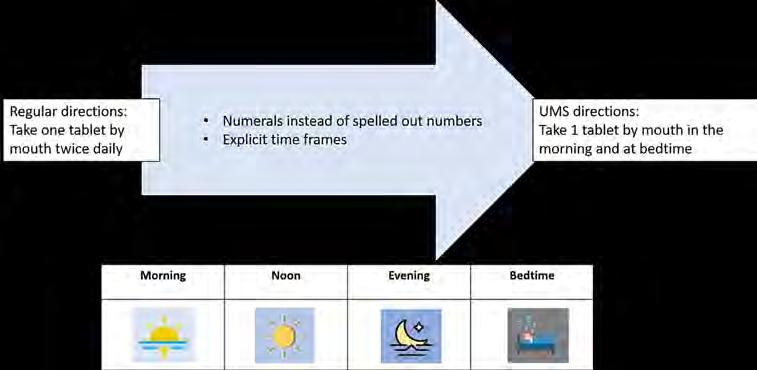
Medication therapy is the mainstay of chronic disease management; yet approximately 50% of patients do not take their medication correctly, forget to take their medication, or stop taking them. One way organizations can help all patients take their medication correctly and consistently is by using Universal Medication Schedule directions. Wisconsin Health Literacy, a non-profit organization based in Madison, Wisconsin, has created a Universal Medication Schedule Toolkit for health systems that would like to adopt this practice to improve medication communication and adherence.
The toolkit was created in Phase 4 of Wisconsin Health Literacy’s Medication Label Initiative to implement patient-centered prescription medication labels. The goal of the initiative is to make it easier for patients to find, understand, and act upon the information on prescription medication labels. As prescription directions (also referred to as prescription sigs) come directly from prescribers, Phase 4 is focused on improving adoption of clearer medication directions by prescribers.
WHA serves on the Project Advisory Council and connects Wisconsin hospitals to these valuable resources.
With generous funding provided by Donate Life Wisconsin through their Impacts Grants program, Midwest Kidney Network invited representatives from WHA, the two Wisconsin organ procurement organizations (Versiti and UW Organ and Tissue Donation), the three Wisconsin transplant hospitals (University of Wisconsin, Froedtert Health, and Children’s Hospital of Wisconsin) and a Wisconsin resident kidney transplant recipient to form the Wisconsin Transplant Leadership Network. In addition to developing the Leadership Network, the goal of the grant was to create inspirational and actionable steps for organizations to impact four areas of transplantation: increasing living donation, increasing deceased donor consent rates, reducing organ discards, and raising awareness of highly effective practices. These goals align with the mission and goals of Donate Life Wisconsin, Midwest Kidney Network and the invited member organizations.
Through the leadership of Jill M. Ellefson, health care consultant, individual needs assessments and best practice interviews were conducted with each member organization. Findings from the participant interviews were used to guide the monthly All Teach All Learn interactive sessions identifying opportunities to spread innovative best practices and establish standardized practices for sustainable improvement. The Leadership Network also provided the opportunity for participating members to develop meaningful connections to fill gaps and enhance relationships to improve organ donation and kidney transplantation rates across Wisconsin.

The Advancing Healthier Wisconsin (AHW) Endowment was established by the Medical College of Wisconsin in 2004. AHW’s funded projects focus on research, community health improvement and health care workforce education and development initiatives.
AHW’s Community-led Seed Grants funding opportunity supports community-MCW academic partnerships to design new strategies, test innovative ideas and foster greater collaboration to address Wisconsin’s leading health challenges.
WHA was one of 31 proposals awarded funding. Of the 40 proposals submitted, AHW’s three oversight bodies—the Medical College of Wisconsin (MCW) Consortium on Public and Community Health, AHW Research and Education Advisory Committee, and MCW Board of Trustees—awarded funding to 31 proposals including 17 research projects and 14 community-based initiatives focused on improving health and advancing health equity across Wisconsin and within specific communities.
WHA’s community-based submission, “Health and Well-Being Environmental Assessment for Lasting Healthcare Workforce Resiliency in Wisconsin” (HEALtHy WI) was selected and awarded one of the seed grants and will be done in partnership with physician leaders from Froedtert & Medical College of Wisconsin, Children’s Wisconsin, and UW Health/University of Wisconsin School of Medicine and Public Health. This initiative will focus on garnering a better understanding of the well-being resources and programs that exist within Wisconsin. The findings will be used to inform and prioritize resources and tools that will be offered to further support Wisconsin hospitals.
For more information on projects funded by AHW, including seed grant awards that take effect in January 2023, visit the funded projects page on the AHW website.
Health care quality is a top priority in Wisconsin hospitals. Hospital leaders, providers and staff experienced another unprecedented year with the continuation of the COVID-19 pandemic, and yet, they met the challenge with patient safety at the forefront of everything they did. Several hospitals that were highly engaged in WHA’s quality initiatives and events in 2022 were recognized Thank you for your dedication to quality improvement and patient safety efforts.
• Bellin Hospital
• Marshfield Medical Center – Beaver Dam
• Black River Memorial Hospital, Inc.
• Memorial Hospital of Lafayette Co.
• Crossing Rivers Health Medical Center
• Mile Bluff Medical Center
• Edgerton Hospital and Health Services
• Reedsburg Area Medical Center
• Fort HealthCare
• Southwest Health
• Grant Regional Health Center
• The Richland Hospital, Inc
• Hayward Area Memorial Hospital & Water’s Edge
• Tomah Health
• HSHS St. Clare Memorial Hospital
• Marshfield Medical Center
• UnityPoint Health - Meriter
• Upland Hills Health, Inc.
The WHA quality team is grateful for the passion, compassion, adaptability, and resilience of all health care professionals throughout the state devoted to serving their patients and communities.
WHA Physician Quality Improvement Advisor Bobby Redwood, MD, presented "What’s Your Antibiotic Stewardship New Year’s Resolution? A Simple Antibiotic Stewardship QI Project for Every Department in the Hospital" webinar on December 6. Dr. Redwood stressed the need to be proactive, preventive and to use antibiotics wisely to prevent multidrug resistant organisms. How do you practice antimicrobial stewardship? Dr. Redwood said the mantra is right diagnosis, right dose and right duration – choose the narrowest of spectrum drug, use the appropriate dose based on patient’s vitals and medical history and choose the shortest duration that will kill the pathogen. He said the goal is to be multidisciplinary across departments. More than 40 participants from Wisconsin hospitals and multiple Minnesota and Michigan hospitals attended the webinar. A link to the webinar can be found on WHA's Ondemand Learning Center
Wisconsin hospitals showcased their quality improvement successes April 18, 2023 at the Capitol Rotunda in a Pre-Advocacy Day Poster Showcase.

Twenty-three posters were featured, representing 50 Wisconsin hospitals and health systems, highlighting their hospitals’ improvement projects. Topics were wide ranging and included Age-Friendly Health Systems, reducing opioid prescriptions, reducing health disparities, and reducing readmissions. Presenters, representing hospital staff responsible for improving patient care, patient safety and access had an opportunity to interact with their legislators and other hospital staff leaders.
See photos from the quality improvement showcase here
Read Wisconsin hospitals' quality improvement stories in the pages ahead.
INTRO: The increase in the number of older adults in the United States is unprecedented. By 2040, the number of older adults is expected to reach 80.8 million. Aging increases the risk of chronic diseases and comorbidities. More than 50% of hospitalized patients in Advocate Health are older adults. It is our commitment to provide excellent clinical care for older adults. The AgeFriendly Health System provides a framework of a set of four evidence-based elements of high-quality care, the “4Ms,” What Matters, Medication, Mentation, and Mobility to improve patient outcomes.
Advocate Health is working on quality improvement efforts utilizing the 4Ms framework to improve care for older adults and increase our patient experience scores for this vulnerable population.
GOAL: Systematically implement the Age-Friendly 4Ms framework in 25 hospitals and achieve Committed to Care Excellence recognition for all 25 hospitals by 2025.
IMPLEMENTATION PLAN:
Our Age-Friendly inpatient implementation began with six hospital sites that were identified as pilot sites. These pilot sites enabled Advocate Health to complete a system gap analysis on the 4Ms framework. This identified opportunities for improvement and set the Advocate Health system standards for Age-Friendly 4Ms implementation.
The plan includes a total of six Cohorts to participate in the IHI/AHA Fall or Spring Action Community and implement Age-Friendly 4Ms at their sites.
SUCCESSES:
• Assessment of Advocate Health’s 4Ms care
• Standardization of the assessment/acting on 4Ms care in our system
• Age-Friendly Participant Recognition- 5 Clinics/9 Hospitals
• Committed to Care Excellence Recognition- 5 Clinics/6 Hospitals
• EPIC Build- What Matters Most
• EPIC Optimization- Mentation Screenings
• Created system Age-Friendly Data Dashboard
• Created Advocate Health system 4Ms Implementation Guide
• Created Automated Audit Tool
• Created system education on implementation of the 4Ms
• Created a sustainability plan
OPPORTUNITY: What Matters Most was identified as our biggest opportunity, as there was not a process in place to assess, document, and act on What Matters Most. Additionally, there was a need across our system to improve patient experience scores for the older adult population 65+. Assessing and incorporating What Matters Most into care delivery provided a solution to improve patient experience.

In response, we worked with our pilot sites to identify the workflow and where this would best live within our electronic health record so that every discipline would be able to:
1. Verify What Matters Most to the patient, and
2. Incorporate that into the care they provide. We also created and embedded scripted questions to not only guide teammates in the assessment of What Matters Most but also to standardize this across our system.
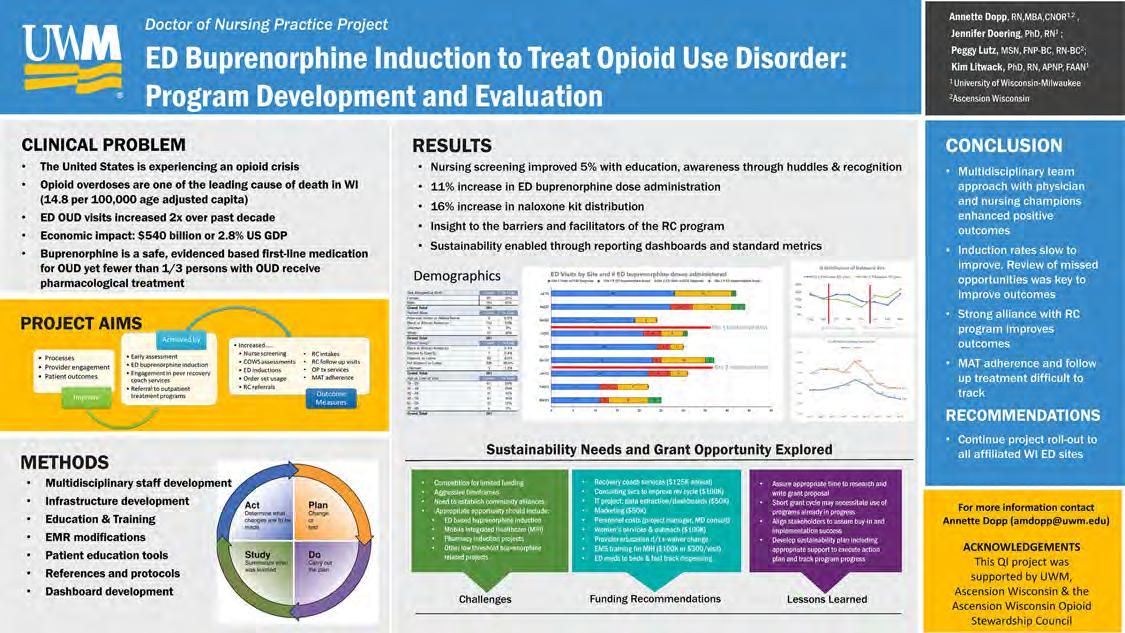
Problem/Significance: Opioid overdoses are one of the leading causes of death in the state of Wisconsin. Emergency Department (ED) visits related to opioid use disorder (OUD) have increased twofold over the past decade thus making them a critical access point well positioned to provide the link for patients to opioid use disorder treatment. Medication-assisted treatment (MAT) plans in addition to counseling and behavioral therapy, are essential to maintaining opioid remission.
Background: Despite evidence that supports starting buprenorphine in the ED, clinicians are reluctant to be prescribers due to lack of training and clinical guidelines.
Purpose: The goal of this doctoral project was to improve the early assessment of OUD, establish a system of care that initiates MAT in the ED, improve compliance with immediate engagement in peer recovery coach services, and referral to outpatient treatment programs.
Method: This program development plan was guided by the plan-do-study-act model and SQUIRE 2.0 (Standards for Quality Improvement Reporting Excellence), which provide a framework for reporting new knowledge about how to improve health care.* The evaluation was guided by Stufflebeam’s** input, process, product (CIPP) model.
Results: Outcomes included a 5% increase in nursing assessments, a 11% increase ED buprenorphine doses administered, a 16% increase in naloxone kit distribution, insight into the barriers and facilitators of the program, as well as the identification of potential programs and services eligible for grant funding.
Conclusion/Implications: Recovery coach programs are a valuable link to sustainable recovery. Implementation of ED buprenorphine inductions programs are complex, iterative processes that need to be tailored to the unique needs of all participants. Program success has the potential to save lives.
Focus on Mobility: The Breakfast Movement is a collaboration between nurses and physical and occupational therapists to assist every able patient with orders for early mobility to get up in the chair for breakfast. The evidenced-based Age Friendly Healthcare 4Ms, which include What Matters, Medication, Mentation, and Mobility were implemented to improve outcomes of older patients during these morning activity opportunities. Why? Immobility can cause 30-60% of older adults to lose their functional ability during a hospital stay. At one year, 30% of these same older adults will not have regained their ability. To assure success in this program is adequate staffing in the morning hours, appropriate supplies stocked the night before by evening staff, and the decision on what to monitor and promote with the patients. The goal is to reduce the prevalence of deconditioning related to immobility in the hospital, so that patients that came from their own home can return home safely.
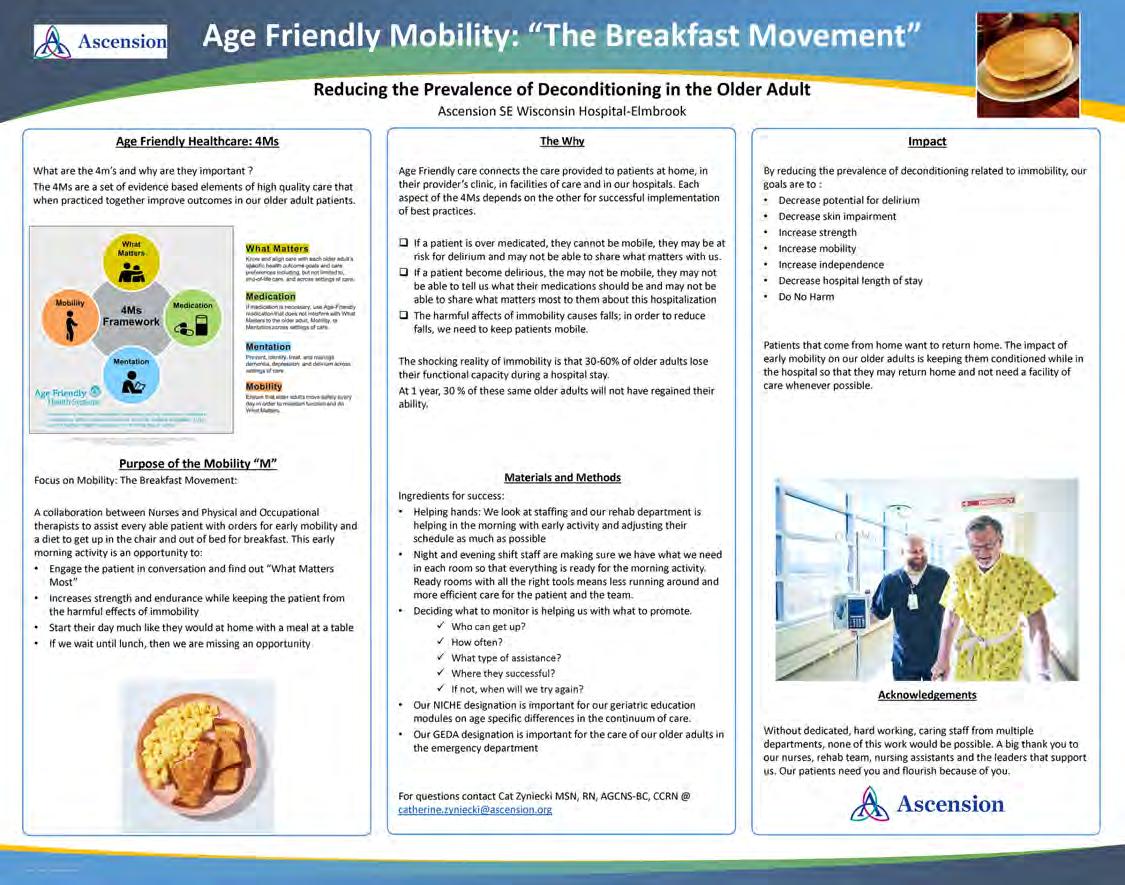
An enhanced focus on reporting potential harm and empowering employees to speak up about safety concerns continues to improve patient safety throughout Bellin Health.

These two critical elements are known as "Good Catches" and "Safety Stops," events that are recognized and corrected by staff before harm occurs to a patient.
• A Good Catch is recognition of an event or circumstance that had the potential to cause injury or illness but did not occur thanks to corrective action or timely intervention following the reporting.
• A Safety Stop is defined as a set of standardized behavioral tools that empower all employees and providers to bring immediate attention to any safety or quality concerns and reach resolution before harm or poor-quality impacts patients or teams. A Safety Stop has two primary elements—communicate clearly and speak up for safety. Bellin encourages all team members to use these tools to maintain a psychologically safe environment in which everyone is empowered to speak up and respectful response is the norm.
Each time an event is reported, it is an opportunity to identify and correct flaws in a process that could potentially jeopardize patient safety. The learnings from Good Catches and Safety Stops are spread throughout the health system to cast a widespread safety net around the patients we care for.
According to the Institute of Medicine, 85% of safety events go unreported. Furthermore, staff members are 10 times more likely to report events that caused harm than events that were caught before harm occurred. There are several barriers to reporting Good Catches and Safety Stops, such as concern over punitive action, lack of confidence that positive change will result, and psychological barriers to admitting an error occurred. It is Bellin’s goal to foster transparent communication throughout the organization and support a “No Blame” culture while reinforcing accountability and learning. Daily huddles that involve all areas of the health system further underscore Bellin’s commitment to this approach.
"After implementing safety huddles, we were able to recognize safety concerns across the organization, not just at a unit level,” said Bellin Director of Nursing & Clinical Practice Ashley Lyman. “Often when looking at just one unit, you can't see a trend. However, when teams start sharing safety issues across the system, trends emerge more quickly and can be addressed in a timely manner. These shared learnings create a just culture, allowing teams to feel comfortable in raising other potential issues or good catches, which results in the ability to fix a problem before an event occurs.”
Ensuring staff members feel safe reporting patient events is vital for continuous improvement. Bellin encourages all staff to participate in safety culture and psychological safety surveys each year to receive feedback on the work environment. The Patient Safety team also presents a Good Catch and Safety Stop award program, which publicly highlights those who report such events on a weekly and monthly basis. Since its inception in late 2021, Bellin’s Good Catch program has celebrated 18 monthly winners. The recognition includes acknowledgment on daily huddles and a surprise ceremony with their peers, in which winners are presented with a certificate and gift card for their efforts to keep our patients safe.
Vice President of Bellin Psychiatric Center Debbie Patz has had success with frontline staff reporting good catches and safety stops.
“Patient and staff safety is our highest priority, and our unit staff members feel empowered to identify and share any potential safety issues in our event system,” Patz said. “This allows for leaders to review and refine our practices, such as our safety search process and how personal items are managed during a patient’s stay with us. We also share ‘good catches’ throughout the system, which is another great way to share learnings because we can learn to be proactive from others.”
Bellin Psychiatric Center also sees benefits of celebrating those who report, Patz said. “It’s wonderful when one of our staff members’ great catches is shared system wide, as it is positive encouragement for them on a job well done,” she said. “It creates a psychologically safe environment for staff to share and know that their concerns and ideas can make a difference.”
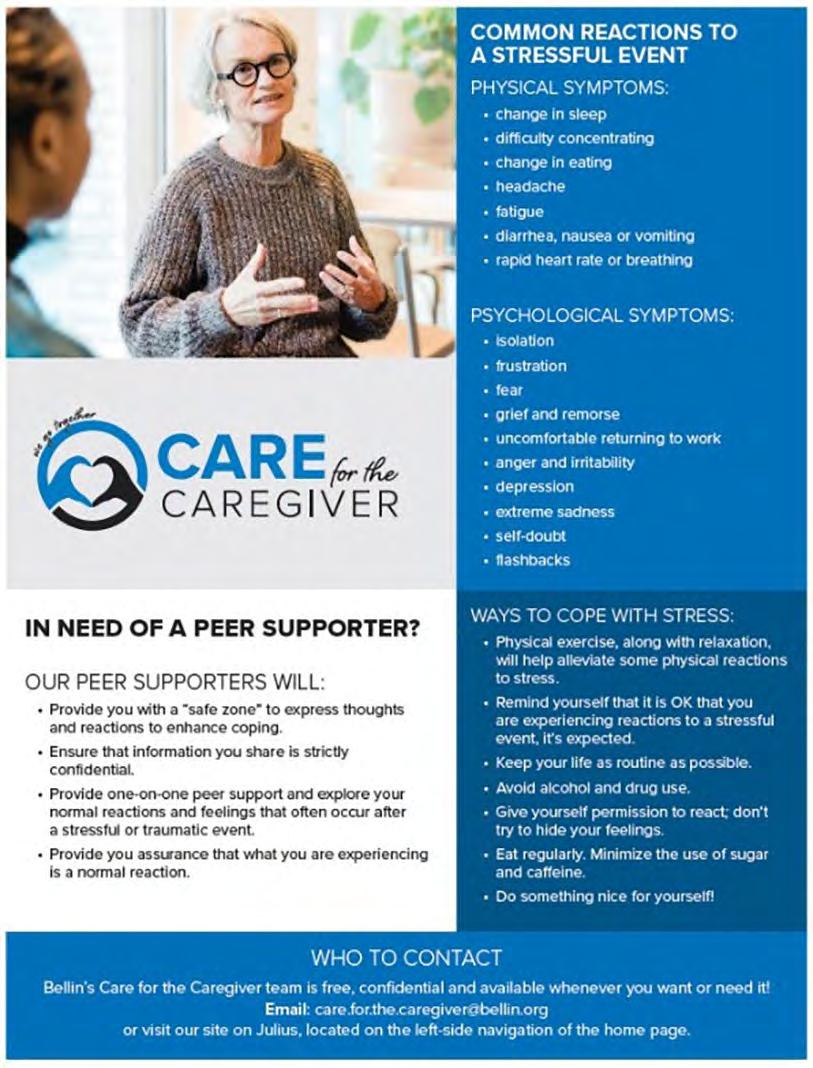
Every day, health care professionals face the risk of traumatic events—such as an unexpected death, a medical error or an unplanned transfer to the ICU. Estimates indicate that approximately 50% of clinicians are involved in an adverse event each year, and too often, these employees experience selfdoubt, burnout and other problems that cause personal anguish and hinder their ability to deliver safe, compassionate care.
In response to this data, Bellin Health created and implemented a peer support group, Care for the Caregiver, made up of passionate, dedicated volunteers. This important task was headed up by Bellin’s Quality and Patient Safety department and officially launched at the beginning of 2023.
In order to build awareness and recruit staff and providers to be part of the Care for the Caregiver program, a comprehensive communication plan was rolled out including branding of the program, updates at monthly leadership meetings, articles on Bellin’s intranet site, flyers and announcements at department huddles and branded jackets featuring the Care for the Caregiver logo for all peer supporters. No peer support program can be a success without the commitment of staff and providers, making it all the more critical to spread the word surrounding the importance of this program and how to get involved. To date, Bellin has had over 90 colleagues in various roles from across Bellin Health step up to be peer supporters.
These volunteer-trained care team members are available to lend a friendly ear and provide support during difficult times. The goal of these connections is for Bellin’s peer supporters to provide quick support and guidance to impacted individuals, address their concerns or worries, and help them cope with any physical and emotional symptoms. This is accomplished by listening, emphasizing self-care and providing resources and referrals to other support organizations within Bellin. All these conversations are completely confidential and legally protected unless there is an issue of personal safety.
Although the Care for the Caregiver program at Bellin is in its infancy, it is a mechanism being embraced and utilized throughout the health system. As the program continues to grow and expand, Bellin’s Quality and Patient Safety Department aims to have a representative from each department serving as a peer supporter for the program.
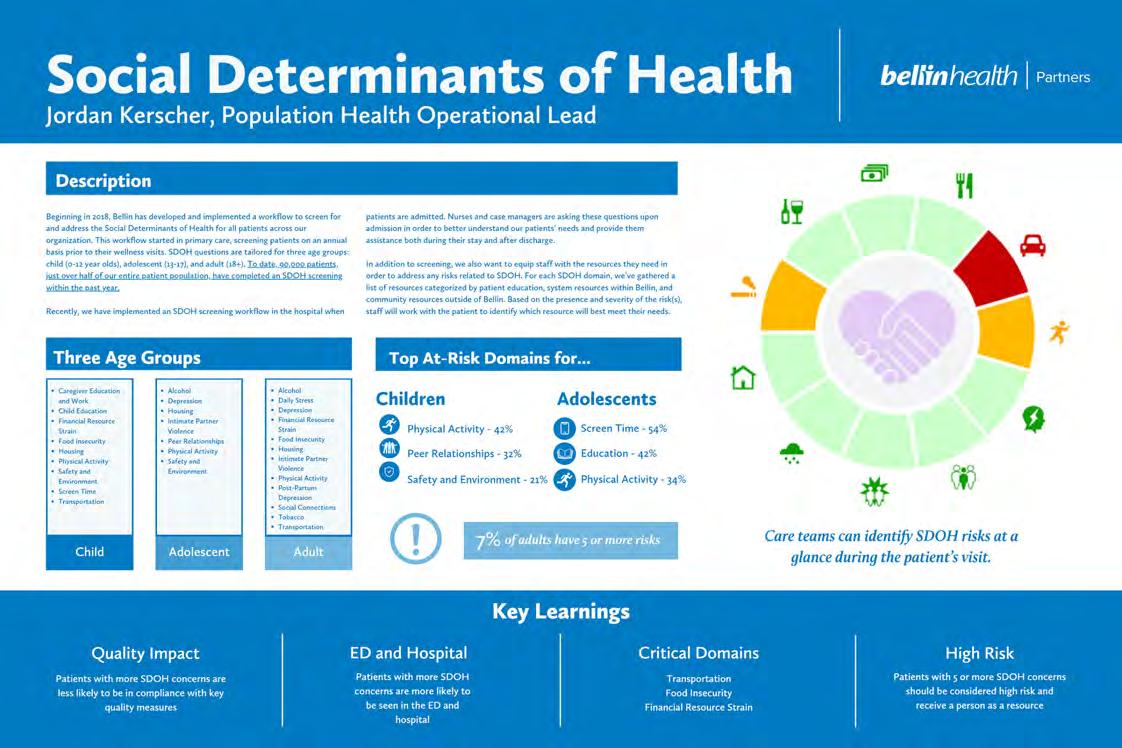
Beginning in 2018, Bellin developed and implemented a workflow to screen for and address the Social Determinants of Health (SDOH) for all patients across the organization. This workflow started in primary care, screening patients on an annual basis prior to their wellness visits. SDOH questions are tailored for three age groups: child (0-12 year olds), adolescent (13-17), and adult (18+). To date, 90,000 patients, just over half of the entire patient population, have completed an SDOH screening within the past year.
Recently, Bellin implemented an SDOH screening workflow in the hospital when patients are admitted. Nurses and case managers are asking these questions upon admission to better understand their patients’ needs and provide assistance both during their stay and after discharge.
In addition to screening, the staff are equipped with the resources they need to address any risks related to SDOH. For each SDOH domain, a list of resources was gathered and categorized by patient education, system resources within Bellin, and community resources outside of Bellin. Based on the presence and severity of the risk(s), staff will work with the patient to identify which resource will best meet their needs.
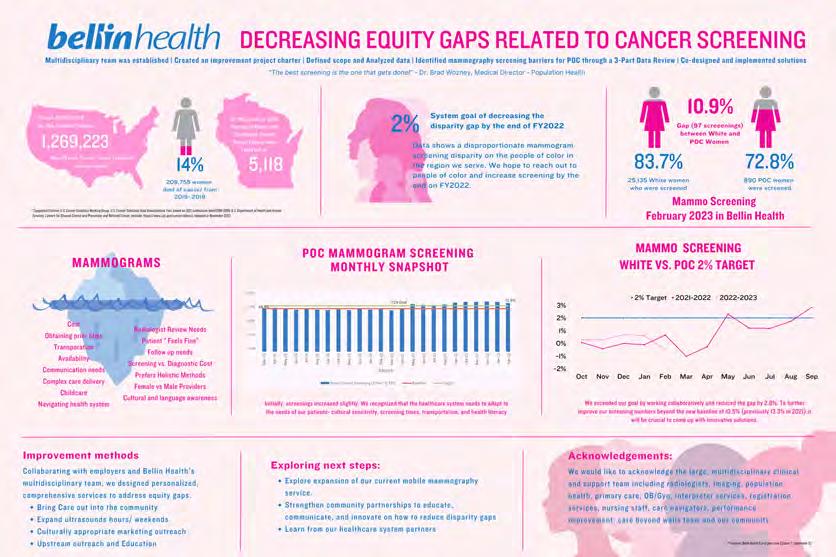
A multi-disciplinary team was established to identify mammography screening barriers at point of care through a three-part data review process. Data shows a disproportionate mammogram screening disparity for people of color in the service region. The goal was to decrease the disparity gap by the end of FY2022. Collaboration with employers and Bellin Health’s multidisciplinary team resulted in a personalized, comprehensive service designed to address equity gaps. The next step in the project is to strengthen partnerships and explore the expansion of current mobile mammography services.

In February 2022, The Stop Sticks Task Force was created to execute a comprehensive strategy to reduce sharps injuries.
Bellin Memorial had experienced a higherthan-average number of sharp injuries when compared to the nation. The purpose of this project was to reduce sharp injuries by 20% in FY 2022 and 50% by the end of FY 2023. Safety Leadership, Safety Culture, and Safe Work Practices/Engineering Controls were included in the strategy and methodology. By February 2023, the program resulted in a reduction of 26 needle sticks in comparison to the number of injuries same time the year prior. As a result of the great improvements from the Stop Sticks Task Force, the team transitioned into the system’s Workforce Safety Committee.
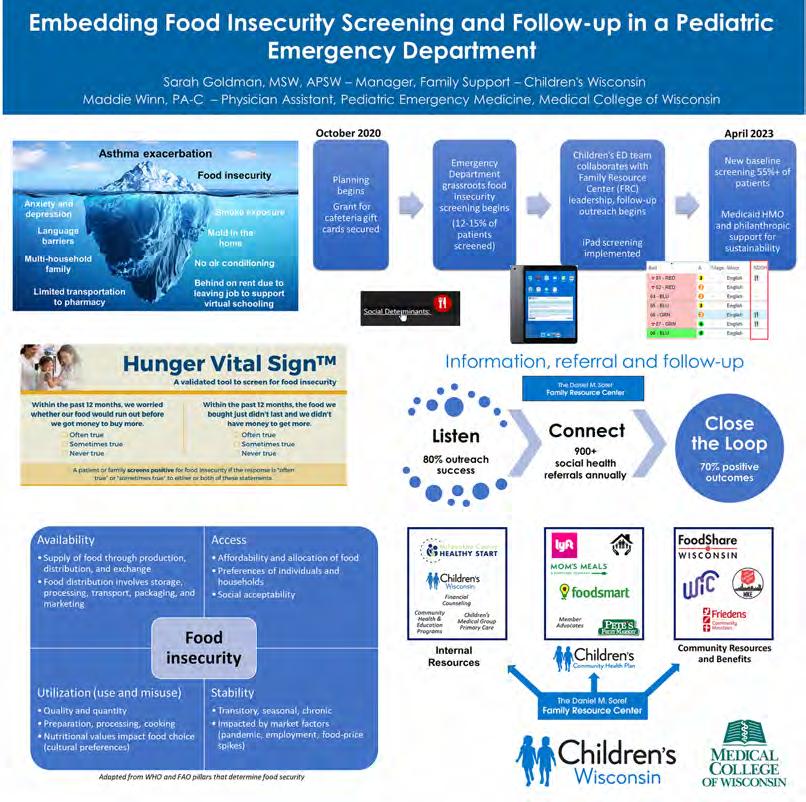
Even before the pandemic, research showed up to 50% of children presenting in Children’s emergency department (ED) experienced food insecurity. Emergency Medicine providers saw firsthand how this was impacting kids and family’s well-being and overall health outcomes. In conjunction with the EDTC’s Social Medicine and Advocacy Committee, these provider leaders advocated implementing food insecurity screening as a standard of care. Grassroots efforts led to a partnership with Children’s Health Management Team and Daniel M. Soref Family Resource center, moving the initiative from grassroots to a full-scale wrap-around care model. Now, over 50-60% of patients are screened for food insecurity, using the national standard Hunger Vital Sign questions, which are documented in the electronic health record. Just as if a provider has ordered a medication, if families screen positive for food insecurity risk, electronic decision support is provided to the nursing team to obtain a $15 cafeteria gift card for the family. This is a key element of the program that offers real-time support as well as a trust building opportunity with the family. The gift card envelope also contains a QR code which links to a resource page with local emergency food and benefits navigation resources.
Within three days of an ED visit, the family receives a call from Children’s Family Resource center team members, who utilize a nationally validated information and referral model to wrap around a family’s holistic needs. Food insecure families are supported with understanding and navigating their FoodShare and WIC benefits or connected with local food pantries. Above and beyond food security resources, families receive support for re-engaging with a primary care medical home, utility assistance, housing navigation, or support navigating the health system for their medical needs. The Family Resource center team can connect with an unprecedented 70% of families after their visit, and six weeks later they close the loop with families to find out if the resources or referrals had a meaningful impact.
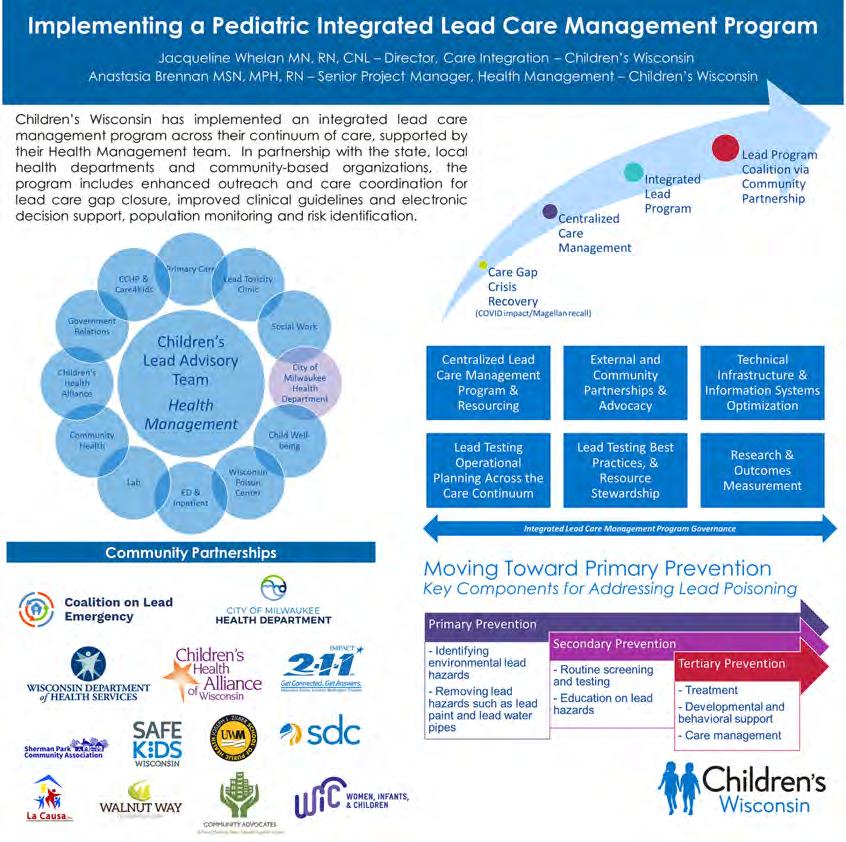
No level of lead is safe in the body of a child. The state of Wisconsin experiences rates of lead poisoning above the national average of 2.5%, with certain neighborhoods in Milwaukee experiencing rates up to 26% of children with elevated blood lead levels. Lead poisoning disproportionately affects families of color and low-income families. During the COVID-19 pandemic, many children missed needed preventive care visits, and the only FDA-approved point of care lead testing device experienced a significant recall. Gaps in lead testing reached a crisis state, with an unknown number of children experiencing lead poisoning. Because of this, Children’s Wisconsin responded by establishing an Integrated Lead Program. This program provided a centralized population surveillance hub with programmatic oversight and two dedicated patient care resources, a lead nurse care manager and a care coordination assistant.
Children’s Integrated Lead Program first focused on secondary and tertiary prevention through improvements to our lead clinical guidelines for our front-line care team members. This improved clarity of what lead testing is needed and when, as well as next steps in a patient’s plan of care based on the type of test (point of care or venous) and the level of the result. The centralized lead team began providing higher touch care management services to children experiencing lead poisoning, implementing bi-weekly case conferences with local health departments and supporting upstream social needs like transportation and food insecurity. They also began significant outreach efforts to support families to be seen for lead testing as well as overall preventive care needs. Additionally, Children’s is dedicated to supporting primary prevention strategies in the community through partnering with community-based organizations like the Coalition on Lead Emergency (COLE), a parent-led organization started by parents of lead-poisoned children to improve community outreach, education, and support.
In early 2022, the Zablocki VA Medical Center Community Living Center (ZVAMC CLC) embarked on the Age-Friendly journey. The care in our CLC was already meeting most of the required elements so all that was needed was to tweak some of the assessment frequencies and submit the required 4Ms care description worksheet. By September, the CLC was recognized as an Age-Friendly Health System Participant.
The next challenge was to earn the Level-2 Age-Friendly designation as: Committed to Care Excellence. All that was needed was to use the 4Ms framework to identify an opportunity for change and adapt. The first Age-Friendly (AF) project was focused on the community homes. Three houses each with 10 veterans are considered to be one neighborhood (unit) of the VA Community Living Center. The resident council voiced the need for all Veteran appointments to be noted on the white board located inside each resident room. The project was rolled out with a brief education on Age-Friendly and the 4Ms framework. The RN and nursing assistant staff were to ensure the Veteran’s upcoming appointments were listed on the white board unless the Veteran opted out. Subsequent audits showed intermittent improvement. Given this, our QAPI group was underwhelmed and decided we should attempt another project to submit for our Level 2 designation.
The QAPI group loved the adoption of use of the VIONE tool. VIONE stands for: Vital, Important, Optional, Not needed, Every medication has an indication. Basically, a mechanism to reduce pill burden and track successes and cost savings. The initial goal is to start small by introducing this one Veteran at a time; currently we have an N=1. VIONE is currently used only for outpatient populations at ZVAMC, however, it has been used successfully at other VA CLCs.


Nationally, the VA is invested in promoting Age-Friendly practices. In early 2022 there were about 10 VAs in the nation which had obtained Institute for Healthcare Improvement Level-2 designation – Committed to Care Excellence; and by the end of the year there are about 40. The VA’s Office of Geriatrics and Extended Care linked with IHI Age-Friendly to adopt a Veteran Friendly model for Age-Friendly Health Systems. The project started the nine-month series in the fall of 2022 and will be completing the series in 2023. We anticipate that AF recognition will be an expectation for all VA CLCs.

In 2018, Door County Medical Center (DCMC) implemented Transitions of Care Management (TCM) for Medicare patients only. Through the COVID pandemic, readmission rates increased significantly and were occurring for many non-Medicare patients within 30-days of discharge. In July 2021, DCMC implemented an expanded TCM program to cover all adults regardless of payor source. In addition to one phone contact and follow-up visit post-discharge, an in-hospital visit was added. This service was also provided for the full 30-days post-discharge. The patient experience, elements of TCM, preventive practices, and diagnosis-specific support were the methods implemented. As a result, all cause readmissions decreased from 5.4% to 3.9% over a period of 12 months. As of March 2023, all cause readmission rate has reduced to 3.1%.

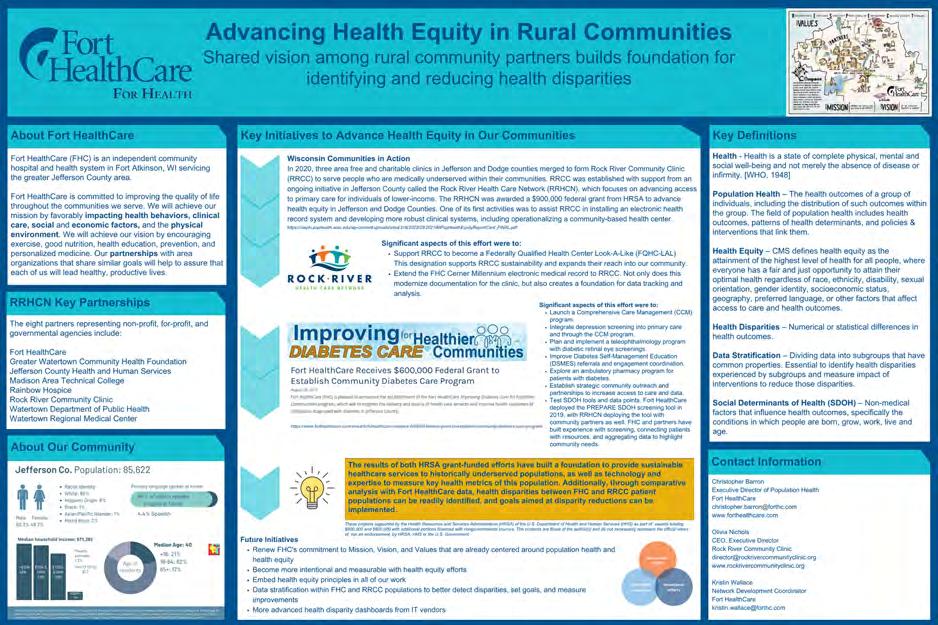
Fort HealthCare’s project, Advancing Health Equity in Rural Communities, describes how a shared vision among rural community partners has built a foundation for identifying and reducing health disparities. This shared vision brought together eight partners representing non-profit, for-profit, and governmental agencies to form the Rock River Health Care Network (RRHCN). The eight partners were Fort HealthCare (FHC), Greater Watertown Community Health Foundation, Jefferson County Health and Human Services, Madison Area Technical College, Rainbow Hospice, Rock River Community Clinic (RRCC), Watertown Department of Public Health and Watertown Regional Medical Center.
The focus of RRHCN is to advance access to primary care for lower-income individuals. Through support from a federal Health Resources and Services Administration (HRSA) grant, existing charity health and dental care organizations consolidated into a single entity (RRCC) with the goal of earning Federally Qualified Health Center Look-A-Like (FQHC-LAL) designation that was awarded December 2022. FQHC-LAL designation supports RRCC sustainability and allows RRCC greater reach into the community.
Fort HealthCare was able to extend their Cerner electronic health record to RRCC which allows RRCC all the benefits of an advanced electronic medical record, including advanced population health management analytics with the Cerner HealtheIntent platform. Fort HealthCare has worked with RRCC to replicate the FHC internal population health management governance and analytics at RRCC. Not only does this support improvement efforts at RRCC, but Fort HealthCare can now measure health disparities between the FHC and RRCC populations, and work together to set improvement goals focused on reducing health disparities. This work is evolving into a disparity tracking scorecard between FHC and RRCC and will likely form the basis for internally stratified disparity tracking.
A tactic to identify root causes of health disparities is to screen for social determinants of health (SDOH), using information from SDOH screenings to both connect patients with resources and inform at a population level of community needs. In 2019, Fort HealthCare was awarded another federal HRSA grant focused on improving diabetes care in the community. One of the key elements of the Improving Diabetes Care for Healthier Communities project was to deploy the PRAPARE SDOH screening tool. The PRAPARE tool has been deployed internally at FHC as well as with several RRHCN partners (Rainbow Hospice and RRCC).
Fort HealthCare is thankful for the many partners that have shared the vision to be the healthiest community in Wisconsin. It is truly a community effort.
As the American population ages, health care systems are faced with providing high-quality care for individuals with serious illness. The John A. Hartford Foundation and the Institute for Healthcare Improvement (IHI) developed the 4Ms (What Matters, Mentation, Medication, Mobility) framework to assist with age-friendly care. Palliative care is a medical specialty that focuses on symptom relief and support of both the patient with a serious illness and the family to align patients' values (what matters) with their health care goals. Palliative Care Fast Facts is a virtual resource providing concise, peer-reviewed, evidence-based summaries of key palliative care topics via a searchable website (www.mypcnow.org/fast-facts).

The aim of our study was to identify if there were Fast Facts that fit within the 4M framework and find a way to make this more accessible to providers. Of the 462 Fast Facts currently published, 32% could be tied to at least one of the 4Ms. The majority (53%) of these were within the What Matters category, followed by Medications (30%), Mentation (12%) and Mobility (5%). An index of the identified Fast Facts was created and in the future the focus will be to make website changes to allow for finding of these fast facts quickly.
Geriatric Fast Facts (www. geriatricfastfacts.com) are concise, practical, evidence-based summaries of key geriatric topics which are designed to be a resource for all faculty and trainees in the health professions. These clinically actionable reports are easily accessible on all mobile devices and are searchable by free text, organ systems, ACGME competencies, and underlying science associated with specific geriatric conditions. In 2022, the 4Ms terms (i.e., what matters, medication, mentation, mobility) were used to categorize the 100 Geriatric Fast Facts that are currently available. Most (62%) of the 100 Geriatric Fast Facts that are currently available were found to be strongly linked to at least a one of the 4Ms, suggesting how central these concepts are to clinical work and geriatric education. Updates to the website will continue in 2023 including the 4Ms as searchable terms and a connection to the Palliative Care Fast Facts site.
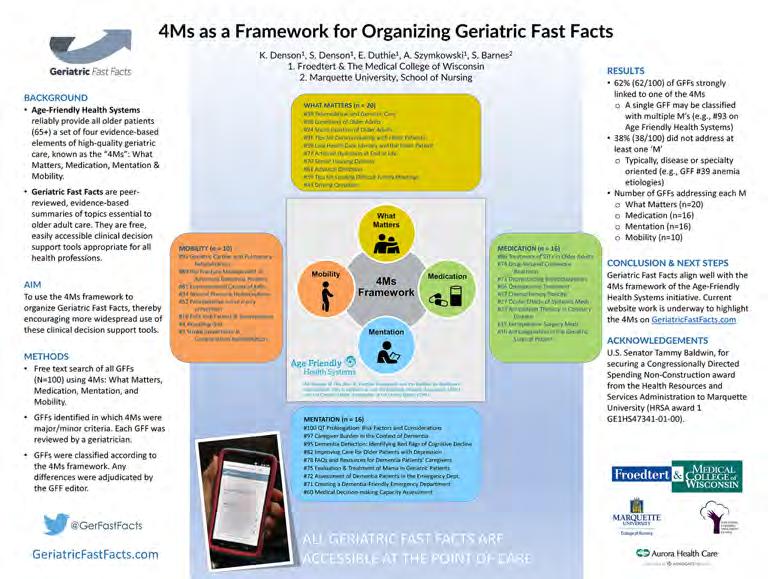
Barcode medication administration (BCMA) is a technology-driven system that helps health care providers ensure the right patient receives the right medication in the right dosage, through the use of barcoded medication and patient identification. It is a critical component of medication safety, and its implementation has been shown to significantly reduce medication errors. Despite the benefits of BCMA systems, compliance with the system can sometimes be a challenge. A recent incident that highlighted this issue was the case of a nurse who faced criminal penalties after inadvertently administering a lethal dose of a paralytic medication to a patient.
This event spurred conversations among hospital leaders determined to find ways to improve BCMA compliance. At Hudson Hospital and Clinic, Emergency Center Nurse Manager Cortney Haus, DNP, MAOL, RN, PHN, TCRN, and Director of Pharmacy Darla Klementz, Pharm D, RPh, led this charge.
Klementz recognized there may be barriers to overcome. “When nurses need to bypass the BCMA process, the system requires them to select the reason for the override. This data allows us to focus on solving those barrier issues.” Most often this includes technical issues, user error, or accessibility problems. “We had to start by focusing on BCMA device accessibility and staff training.”

Haus, using the knowledge recently gained through her DNP program, understood the importance of cultivating a culture of safety that encourages staff to report medication errors and near misses without fear of retribution.
“This confidence emboldens nurses to take immense pride in their personal and professional practice and recognize that their daily actions are essential in ensuring patient safety," said Haus. "During one-on-one meetings with staff members it was emphasized to follow commitment to safe patient care by utilizing BCMA technology whenever possible. If there are situations where this is not possible, it’s important that we look for solutions to overcome those obstacles.”
Leveraging technological resources was key. The hospital’s analytics database provides leaders with a breakdown of compliance of medication scanning versus patient, scanning by department, and then by individual. Providing feedback on an individual level is paramount. The Emergency Center nurses can see their overall team scores and also a list of those individual superstars who surpass the 95% goal. Emphasizing the significance of each person’s professional practice fosters a culture of safety.
To keep the momentum of this work moving in the right direction the team is utilizing the electronic patient safety reporting system. It is here that nurses report when a medication won’t scan due to labeling issues or other technological issues. Medication errors and near misses can be flagged for contributing factors such as BCMA override. Reports run from the system help feed the medication safety discussions across the hospital. The positive improvements in the Emergency Center have been replicated in other departments.

Healthcare-associated infections (HAIs) are among the fastest growing issues affecting health care facilities in the United States. The National Healthcare Safety Network (NHSN) and the Centers for Disease Control and Prevention (CDC) monitor them very closely. Hospitals nationwide perform surveillance to prevent HAIs and improve patient safety. At the beginning of 2022, it was identified that the Standardized Infection Ratio (SIR) for healthcare-associated Clostridioides difficile (HAI CDI) was trending upward at Marshfield Medical Center-Beaver Dam (MMC-BD). The Infection Preventionist along with the Quality/ Patient Safety/Risk Management/Performance Improvement Manager investigated the current state of HAI CDI at MMC-BD with the goal of reducing the SIR for the inpatient Medical/Surgical/Intensive Care Units by 20% by the end of 2022.
In the investigation, it was identified that the CDI lab test was part of the GI stool panel. It was also discovered that in the current electronic medical record, the CDI order remained active until the stool sample was collected and sent, regardless how long it took to obtain the sample. Both of these could lead to inappropriate CDI testing. To help ensure appropriate CDI testing, the following counter measures were identified and implemented:
• Conducted real-time report-outs to evaluate the five “whys” to identify the root cause.
• Reported fallouts monthly to the MMC-BD executive team which became part of the quality and process improvement’s leadership performance evaluation goals to assist with transparency and accountability.
• Performed a major education initiative on the Bristol Stool Chart for all inpatient staff including education on the MCHS Inpatient Adult CDI Testing Algorithm. This was accomplished by the infection preventionist attending nursing huddles, developing an educational poster for the Nursing Skills Fair, and handing out “pocket cards” to nursing staff that had the Bristol Stool Chart with types of stool on one side and the approved Inpatient Adult CDI Testing Algorithm on the other.
• Provided education to physicians and nurse practitioners on the criteria for ordering CDI analysis and the established Inpatient Adult CDI Testing Algorithm.
• Sent reminder emails to laboratory staff to reject any stool sample with formed stool that were sent for CDI testing.
• Transitioned to a different EMR, which removed the CDI lab from the GI stool panel. The CDI lab order also “fell off” after 24 hours if the sample was not obtained and sent, prompting the provider to reorder and again meet criteria for ordering the lab.
When all countermeasures were implemented, MMC-Beaver Dam saw significant results. The HAI CDI SIR was 0.00 for quarters 2 through 4 of 2022. CDI results will continue to be monitored to support appropriate patient testing.

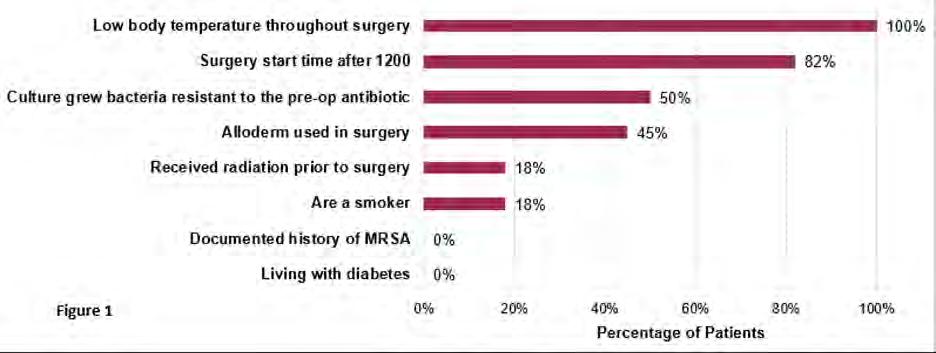
Surgical site infections (SSIs) are the most common health care-related complication. These develop in 2-5% of the more than 30 million patients undergoing a surgical procedure every year. This complication delays the healing process and can consequently keep patients from returning to work and their everyday lives. It is also associated with increased costs and a higher risk of postoperative mortality.
Following the National Health and Safety Network (NHSN) guidelines for identifying a SSI, Marshfield Clinic Health System’s Infection Prevention noted 11 SSIs in the NHSN BRST (breast) category from 11/2018 to 10/2019 in procedures spanning anywhere from a lumpectomy to breast reconstruction with an implant.
Infection Prevention began an investigation into the BRST SSIs in the fall of 2019 to identify areas for improvement. This involved a thorough examination of medical records and direct observation of BRST cases in the operating room (OR). During the record review it was noted that 100% of the patients had low body temperatures throughout surgery and 50% of the patients who had a culture collected grew bacteria that was resistant to the pre-operative antibiotic. In most cases this was Clindamycin, which was given due to allergy concerns. A bit surprisingly, none of the patients were diabetic (See Figure 1.)
Infection Prevention presented the findings from the record reviews and direct OR observations with recommendations to the surgery team in the winter of 2020. Several initiatives were implemented that included chlorhexidine gluconate bathing prior to surgery, maintaining normothermia, antibiotic stewardship, and limiting OR traffic (including not allowing relief of the surgical technologist during handling of breast implants).
Even with the challenges brought by the COVID-19 pandemic the Outpatient Surgery Center team has been successful in making significant improvements in the number of BRST SSIs with only two SSIs identified in 2022.
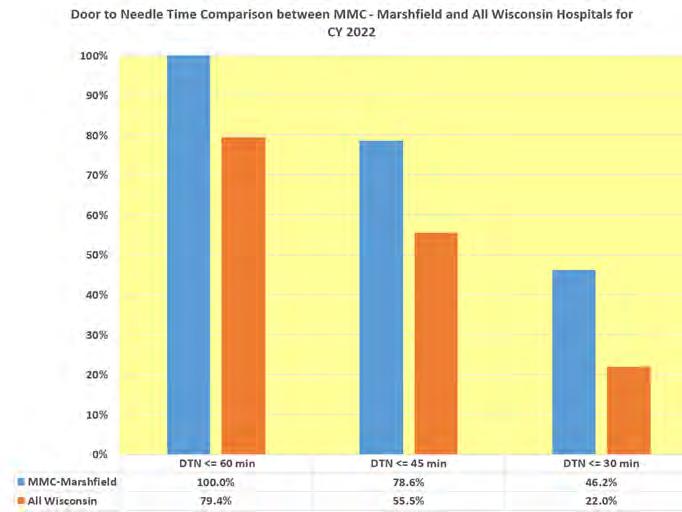
Because stroke is a leading cause of death, the American Heart Association and American Stroke Association have implemented the national quality improvement initiative, “Target Stroke,” to improve the care of stroke patients. Target Stroke focuses on reducing door-to-needle times in acute ischemic stroke patients and on increasing the portion of eligible patients who receive “clot busting” thrombolytic therapy within 60 minutes after hospital arrival.
To maximize the clinical benefit for the acute ischemic stroke population, Marshfield Medical Center began a focused initiative to shorten door-to-needle time for IV thrombolytic administration. The project was led by the Stroke Performance Improvement Team and required a collaborative effort by clinicians from neurology, emergency medicine, radiology, laboratory, pharmacy, EMS and administrative staff.
To decrease the overall time from patient entry to IV thrombolytic administration within the 60-minute “Target Stroke” timeframe, the following Code Stroke time goals were set, and each phase of the process was examined to identify improvement opportunities to meet these goals:
Code Stroke Time Goals:
Door to MD 5 minutes
Door to Code Stroke 10 minutes
Door to CT 15 minutes
Door to CT Report 25 minutes
Door to ISTAT PT/INR 20 minutes
“Code Stroke” protocol modifications were made to help achieve these time goals.
• Pre-hospital notification by EMS.
» Education provided to EMS providers and medical transporters regarding warning signs and recommended EMS response to suspected stroke.
• Activation of “Code Stroke” team via pager.
• Stroke patients triaged directly to the CT scanner for initial neurologic examination and brain imaging to determine thrombolytic eligibility. In some scenarios, patients transfer directly from the ambulance bay to CT.
• ISTAT to measure international normalized ratio for anticoagulated patients. Glucose testing by EMS in the field or prior to arrival as applicable.
• Thrombolytic mixing and administration in the CT scanner, as soon as hemorrhage ruled out by neurologist. Recently, the conversion was made in the thrombolytic medication from Alteplase to Tenectaplase to simplify the administration process.
For continuous improvement, the multidisciplinary Stroke Performance Improvement Team reviews all Code Stroke patient cases and target time data to identify further opportunity for additional provider/staff/EMS education or modification of stroke protocols. The data is also shared with all stakeholders and improvements are celebrated by the stroke care team.
Marshfield Medical Center-Park Falls (MMC-PF) is a CMS certified swing bed hospital. For patients receiving swing bed care (e.g. post-acute care), the need to strengthen interdisciplinary communication to help patients reach mobility and self-care goals to heal and return home as soon as possible was identified. With the goal of strengthening communication between therapy staff, nursing, the patient and the patient’s family and to improve the hospital’s swing bed metrics, MMC-PF participated in Stroudwater’s Swing Bed Quality Improvement Project (funded through the Office of Rural Health) from late fall of 2021 through June 2022.
Qualitative Results:
¾ Increased communication between therapy staff, nursing, and the patient
¾ Education for nursing staff on the difference between post-acute and acute care (with special focus on motivating patients to do things for themselves)
¾ Utilization of the whiteboard to outline clear expectations for staff, patients, and patients' families, and
¾ Development of a plan for each nursing shift to work with patients on reaching self-care and mobility goals
A team consisting of quality, nursing and therapy was assembled to review and discuss the current state of the swing bed program, analyze available data and identify the desired outcomes and goals of the QI project. Based on the discussion and data review, MMC-PF selected strengthening “mobility and self-care metrics” to promote positive patient outcomes and worked with Stroudwater to employ the following tools and resources:
• Stroudwater’s Swing Bed Quality Assurance Performance Tool
• Training and education for the Swing Bed Quality Improvement Project
• Peer-to-peer networking meetings
• Action planning, data trending, and benchmarking
Although baseline data was not available for the purpose of comparison, the team felt that the QI project was a huge success per qualitative and quantitative results. The collaboration MMC-PFs had with Stroudwater resulted in a clear process that is followed when patients are admitted to a swing bed at MMC-PFs and significant improvement in communication and care coordination which have all led to meeting the patient’s mobility and self-care goals and a timelier discharge.
Quantitative Results:
Risk adjusting the mobility and self-care assessments produced an expected improvement score for mobility and self-care. Stoudwater compared the actual improvement score to the expected improvement score and calculated the percentage of discharges that met or exceeded the expected improvement score. There were seven swing bed patients during the time frame.
¾ Mobility: 42.9%, which is better than the national median of 27%
¾ Self-care: 71.4%, which is better than the national median of 48%
In 2021, Marshfield Medical Center-Weston infection prevention identified a sharp increase in surgical site infections (SSI) involving colorectal surgeries. In collaboration with the surgical services team and direct observations by infection prevention during surgeries, a thorough investigation into the surgical site infection (SSI) cases was conducted. The Marshfield Clinic System initiative named the Colon Premier Care Project had been initiated in 2019, but the COVID-19 pandemic prevented full implementation. A small workgroup met to compare the project practice bundle to current practice. There were several areas that had opportunities for improvement. After implementation of the colon SSI prevention bundle, these measures were tracked during active surveillance by infection prevention. This resulted in a significant reduction in SSI among colorectal surgeries. Zero complex infections have been observed since 2021.
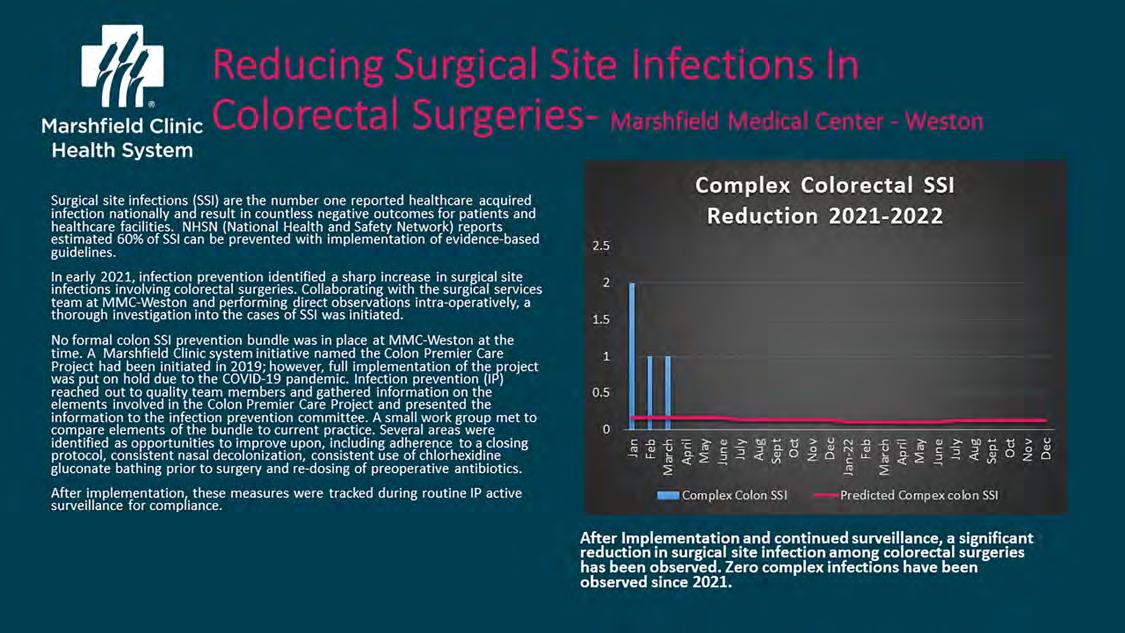
Identifying Local Barriers to Mammography in Women Served by a Rural Acute Care Hospital
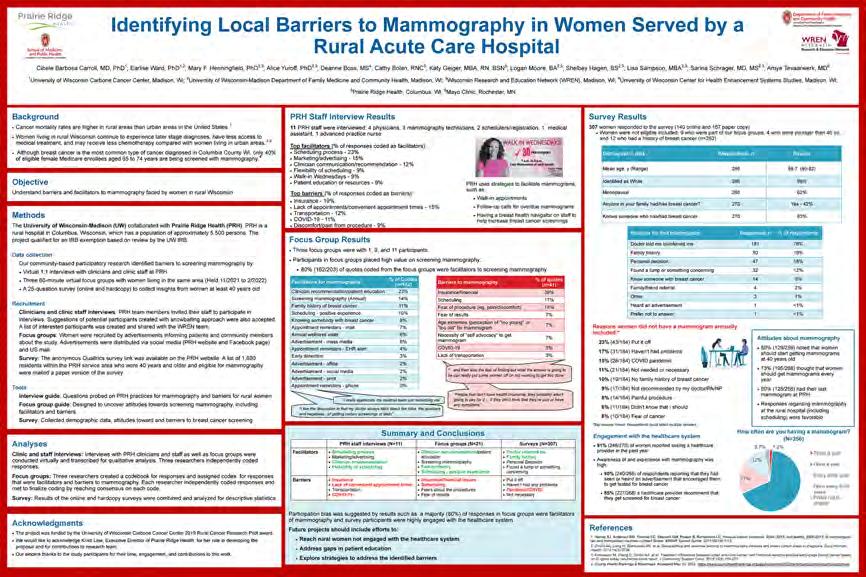
Prairie Ridge Health (PRH), in partnership with the University of Wisconsin-Madison (UW), sought to understand barriers and facilitators to screening mammography faced by women living in the catchment area of this critical access hospital located in Columbus, WI. We conducted virtual interviews with PRH staff, virtual focus groups with women from the community, and a survey (online and paper copy) of women ≥ 40 years to collect insights from multiple stakeholders.
PRH staff and focus group participants reported similar facilitators (clinician recommendation, positive experience with scheduling) and barriers (insurance, lack of convenient appointment times/problems with scheduling) to screening mammography. Among survey participants (n=307), 50% had their last screening mammography at PRH, 91% reported seeing a health care provider in the past 12 months, and 85% had a health care provider recommending they get screened for breast cancer. The survey responses regarding mammography screening at the rural hospital were favorable.
Future projects will concentrate efforts to address the barriers identified, reach rural women not engaged with the health system, and improve education regarding mammography screening.
Authors:
• Cibele B. Carroll, MD, PhD1
• Amye J. Tevaarwerk, MD2
• Mary F. Henningfield, PhD3,5
• Alice S. Yuroff, PhD3,5
• Cathy Bolan, RNC4
• Katy Geiger, MBA, RN, BSN4
• Earlise C. Ward, PhD1,5
• Sarina Schrager, MD, MS3,5
1 UW Carbone Cancer Center, Madison WI
2 Mayo Clinic Cancer Center, Rochester MN
3 Wisconsin Research and Education Network (WREN), Madison WI
4 Prairie Ridge Health, Columbus WI
5 UW Department of Family Medicine and Community Health, Madison, WI
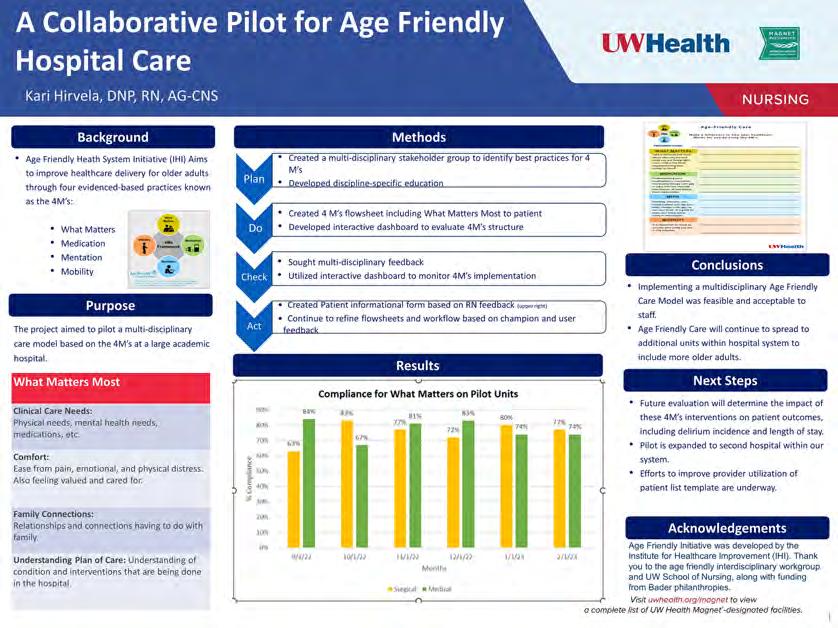
UW Health formed a multidisciplinary team to develop a pilot program for one medical and one surgical inpatient unit. Using a plan-do-check-act (PDCA) quality improvement process, the team accomplished the following:
• Identified best practices for 4Ms currently being utilized on pilot units and looked for ways to optimize gaps in care
• Developed discipline-specific education about the 4Ms
• Created a 4Ms nursing flowsheet within Health Link, including a patient section expanded to include “What Matters”
• Developed interactive dashboard to evaluate the 4Ms structure
• Sought multi-disciplinary feedback
• Created a new patient informational form based on RN feedback
• Utilized an interactive dashboard to monitor 4Ms implementation
• Continue PDCA cycles to refine flowsheets and workflow based on champion and user feedback
Looking more closely at “What Matters,” patients are now regularly asked about what is most important to them in terms of:
• Clinical Care Needs: Physical needs, mental health needs, medications, etc.
• Comfort: Ease from pain, emotional, physical distress; feeling valued and cared for
• Family Connections: Relationships with family and significant others
• Understanding Their Plan of Care: Patients’ understanding of their condition and interventions that are being done in the hospital
In addressing “Mentation,” UW Health chose to focus on the care of the patient with dementia. The result is the development of a unique evidence-based care assessment, “Patient-Specific Dementia Information,” which provides staff with easily accessible information in Health Link regarding individual patient’s cognitive/functional baseline, behaviors and social history. This can be used to inform assessments, individualize the patient’s plan of care and improve continuity of care and transitions across settings.
UW Health has expanded these Age-Friendly care practices to their East Madison Hospital and will continue to expand across the UW Health inpatient settings. Of note, in 2022 UW Health received a grant from Bader Philanthropies in collaboration with the UW School of Nursing to support the spread and optimization of Age-Friendly care. Future evaluation will determine the impact of the 4Ms interventions on patient outcomes, including delirium incidence and length of stay.
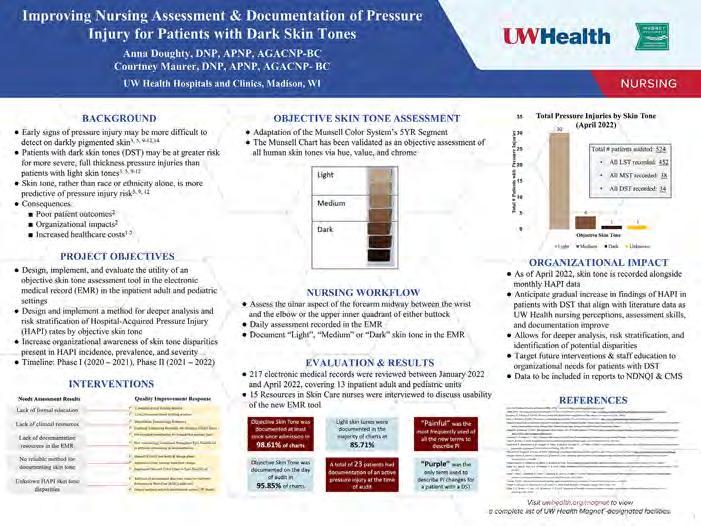
Early signs of pressure injury may be more difficult to detect on patients with dark skin pigmentation. Patients with dark skin tones may be at greater risk for more severe, full thickness pressure injuries than patients with light skin tones. Objective skin tone assessment, modifications in nursing workflows, and other quality improvement interventions were implemented. Objective skin tone assessment was completed by implementation of the Munsell Chart, which has been validated as an objective assessment of human skin tones. Between January 2022 and April 2022, 217 electronic medical records were reviewed. This covered 13 inpatient adult and pediatric units. As of April 2022, skin tone is recorded alongside monthly quality data. Deeper analysis, data collection and reporting, and targeted future interventions were just a few of the organizational impacts of this quality improvement project.
While participating in the University of Wisconsin Hospital and Clinics, Madison Improvement Surgical Care and Recovery Quality and Safety Program, delirium was made a priority by the Emergency General Surgery (EGS) service. The Plan-Do-CheckAct method was utilized in this quality improvement project. Patients greater than 65 years of age on the EGS service were included. A multi-disciplinary team of health care professionals attended, and documentation included daily rounding questions based on the 4M Model. Rounding began in January 2022 and the priorities included patient assessment, medication optimization, environmental/sensory, and cognitive stimulation. Developed patient care communication and education to units. Met with the multi-disciplinary team for feedback and analyzed efficiency of the rounds. Results included 184 patients who met criteria for rounding and 141 patients were rounded on. Continuation of delirium rounds improved medication optimization resulting in decrease in changes during rounds.


At Westfields Primary Care Clinic, the challenge was clinician frustration around too much time in their In-Basket in the electronic record, particularly outside of scheduled hours. Concerns were identified regarding the Right Person, Right Message, and Right Work. After identifying barriers such as finding objective data, abbreviated staff onboarding during COVID, and lack of clear team communication, a best-practice approach was implemented. As a result of this quality improvement project, over 40% improvement in self-reported clinician satisfaction occurred. Other benefits were 35% reduced pajama time (average 41 minutes to 26.5 minutes), decreased hourly In-Basket outside of scheduled hours, increased interdepartmental communication, and increase in clinician engagement.
The William S. Middleton Memorial VA hospital in Madison has been committed to improving the care for aging Veterans including the support of the Elder Veteran Program (EVP). EVP is a nursing-led approach to deliver inpatient consultative geriatrics care at the hospital. Much of the care provided on EVP already addressed many components of IHI’s Age-Friendly 4Ms, though not consistently. EVP committed to reliably providing the 4Ms to all older adults seen in the program by modifying workflows and documentation using a Plan-Do-StudyAct approach, resulting in improvements in the frequency of documentation of the 4Ms. Overall, the project demonstrates a novel way to integrate the 4M elements into a hospital system by leveraging an existing nursing-led geriatric consult service focused on prevention and education.
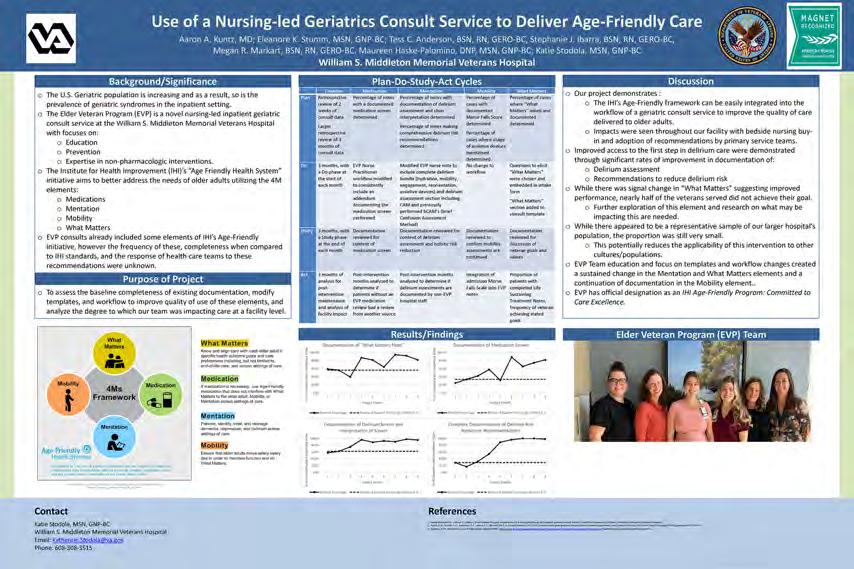
AdventHealth, Durand
Amery Hospital & Clinic, Amery
Ascension All Saints Hospital, Racine
Ascension Calumet Hospital, Chilton
Ascension Columbia St. Mary's Hospital, Milwaukee
Ascension Columbia St. Mary's Hospital Ozaukee, Mequon
Ascension NE Wisconsin - Mercy Campus, Oshkosh
Ascension NE Wisconsin - St. Elizabeth Campus, Appleton
Ascension Sacred Heart Rehabilitation Hospital, Mequon
Ascension SE Wisconsin Hospital - Elmbrook Campus, Brookfield
Ascension SE Wisconsin Hospital - Franklin Campus, Franklin
Ascension SE Wisconsin Hospital - St. Joseph Campus, Milwaukee
Ascension St. Francis Hospital, Milwaukee
Ascension Wisconsin Hospital, Greenfield
Ascension Wisconsin Hospital, Menomonee Falls
Ascension Wisconsin Hospital, Waukesha
Aspirus Divine Savior Hospital & Clinics, Portage
Aspirus Eagle River Hospital, Eagle River
Aspirus Langlade Hospital, Antigo
Aspirus Medford Hospital & Clinics, Inc., Medford
Aspirus Merrill Hospital, Merrill
Aspirus Plover Hospital, Stevens Point
Aspirus Rhinelander Hospital, Rhinelander
Aspirus Riverview Hospital & Clinics, Inc., Wisconsin Rapids
Aspirus Stanley Hospital, Stanley
Aspirus Stevens Point Hospital, Stevens Point
Aspirus Tomahawk Hospital, Tomahawk
Aspirus Wausau Hospital, Wausau
Aurora BayCare Medical Center, Green Bay
Aurora Lakeland Medical Center, Elkhorn
Aurora Medical Center - Bay Area, Marinette
Aurora Medical Center, Grafton
Aurora Medical Center, Kenosha
Aurora Medical Center, Mount Pleasant
Aurora Medical Center, Oshkosh
Aurora Medical Center, Sheboygan
Aurora Medical Center, Summit
Aurora Medical Center - Washington County, Hartford
Aurora Medical Center, Burlington
Aurora Medical Center Manitowoc County, Two Rivers
Aurora Psychiatric Hospital, Wauwatosa
Aurora Sinai Medical Center, Milwaukee
Aurora St. Luke's Medical Center, Milwaukee
Aurora St. Luke's South Shore, Cudahy
Aurora West Allis Medical Center, West Allis
Bellin Health Oconto Hospital, Oconto
Bellin Hospital, Green Bay
Bellin Psychiatric Center, Green Bay
Beloit Health System, Beloit
Black River Memorial Hospital, Inc., Black River Falls
Burnett Medical Center, Grantsburg
Children's Wisconsin - Fox Valley Hospital, Neenah
Children's Wisconsin - Milwaukee Hospital, Milwaukee
Clement J. Zablocki VA Medical Center, Milwaukee
Crossing Rivers Health Medical Center, Prairie du Chien
Cumberland Healthcare, Cumberland
Door County Medical Center, Sturgeon Bay
Edgerton Hospital and Health Services, Edgerton
Essentia Health St. Mary's Hospital, Superior
Fort HealthCare, Fort Atkinson
Froedtert Bluemound Rehabilitation Hospital, Wauwatosa
Froedtert Community Hospital, Mequon
Froedtert Community Hospital, New Berlin
Froedtert Community Hospital, Oak Creek
Froedtert Community Hospital, Pewaukee
Froedtert Holy Family Memorial, Manitowoc
Froedtert Hospital, Milwaukee
Froedtert Menomonee Falls Hospital, Menomonee Falls
Froedtert West Bend Hospital, West Bend
Granite Hills Hospital, West Allis
Grant Regional Health Center, Lancaster
Gundersen Boscobel Area Hospital and Clinics, Boscobel
Gundersen Lutheran Medical Center, La Crosse
Gundersen Moundview Hospital and Clinics, Friendship
Gundersen St. Joseph's Hospital and Clinics, Hillsboro
Gundersen Tri County Hospital & Clinics, Whitehall
Hayward Area Memorial Hospital & Water's Edge, Hayward
Howard Young Medical Center, Woodruff
HSHS Sacred Heart Hospital, Eau Claire
HSHS St. Clare Memorial Hospital, Oconto Falls
HSHS St. Joseph's Hospital, Chippewa Falls
HSHS St. Mary's Hospital Medical Center, Green Bay
HSHS St. Nicholas Hospital, Sheboygan
HSHS St. Vincent Hospital, Green Bay
Hudson Hospital & Clinic, Hudson
Indianhead Medical Center, Shell Lake
Lakeview Specialty Hospital & Rehab, Waterford
Marshfield Medical Center, Marshfield
Marshfield Medical Center, Beaver Dam
Marshfield Medical Center, Eau Claire (continued on next page)
Marshfield Medical Center, Ladysmith
Marshfield Medical Center, Minocqua
Marshfield Medical Center, Neillsville
Marshfield Medical Center, Park Falls
Marshfield Medical Center, Rice Lake
Marshfield Medical Center, Weston
Marshfield Medical Center-River Region, Stevens Point
Mayo Clinic Health System - Chippewa Valley, Bloomer
Mayo Clinic Health System, Eau Claire
Mayo Clinic Health System, La Crosse
Mayo Clinic Health System - Northland, Barron
Mayo Clinic Health System - Oakridge, Osseo
Mayo Clinic Health System - Red Cedar, Menomonie
Mayo Clinic Health System, Sparta
Memorial Hospital of Lafayette Co., Darlington
Memorial Medical Center, Ashland
Mercyhealth Hospital and Medical Center - Walworth, Lake Geneva
Mercyhealth Hospital and Trauma Center, Janesville
Midwest Orthopedic Specialty Hospital, Franklin
Mile Bluff Medical Center, Mauston
Milwaukee Rehabilitation Hospital, Greenfield
Miramont Behavioral Health, Middleton
Orthopaedic Hospital of Wisconsin, Glendale
Osceola Medical Center, Osceola
Prairie Ridge Health, Columbus
ProHealth Oconomowoc Memorial Hospital, Oconomowoc
ProHealth Rehabilitation Hospital of Wisconsin, Waukesha
ProHealth Waukesha Memorial Hospital, Waukesha
ProHealth Waukesha Memorial Hospital, Mukwonago
Reedsburg Area Medical Center, Reedsburg
River Falls Area Hospital, River Falls
Rogers Behavioral Health, Oconomowoc
Sauk Prairie Healthcare, Prairie du Sac
Select Specialty Hospital - Milwaukee - St. Francis, Milwaukee
Select Specialty Hospital - Milwaukee, West Allis
Select Specialty Hospital, Madison
Southwest Health, Platteville
Spooner Health, Spooner
SSM Health Monroe Hospital, Monroe
SSM Health Ripon Community Hospital, Ripon
SSM Health St. Agnes Hospital, Fond du Lac
SSM Health St. Clare Hospital, Baraboo
SSM Health St. Mary's Hospital, Madison
SSM Health St. Mary's Hospital, Janesville
SSM Health Waupun Memorial Hospital, Waupun
St. Croix Health, St. Croix Falls
Stoughton Health, Stoughton
The Richland Hospital, Inc., Richland Center
ThedaCare Medical Center, Berlin
ThedaCare Medical Center, New London
ThedaCare Medical Center, Shawano
ThedaCare Medical Center, Waupaca
ThedaCare Medical Center, Wild Rose
ThedaCare Regional Medical Center, Appleton
ThedaCare Regional Medical Center, Neenah
Tomah Health, Tomah
Tomah VA Medical Center, Tomah
UnityPoint Health - Meriter, Madison University Hospital, Madison
Upland Hills Health, Inc., Dodgeville
UW Health - East Madison Hospital, Madison
UW Health Rehabilitation Hospital, Madison
Vernon Memorial Healthcare, Viroqua
Watertown Regional Medical Center, Watertown
Western Wisconsin Health, Baldwin
Westfields Hospital & Clinic, New Richmond
William S. Middleton Memorial Veterans Hospital, Madison
Willow Creek Behavioral Health, Green Bay
